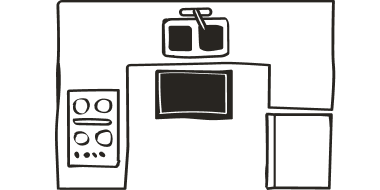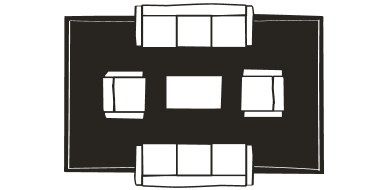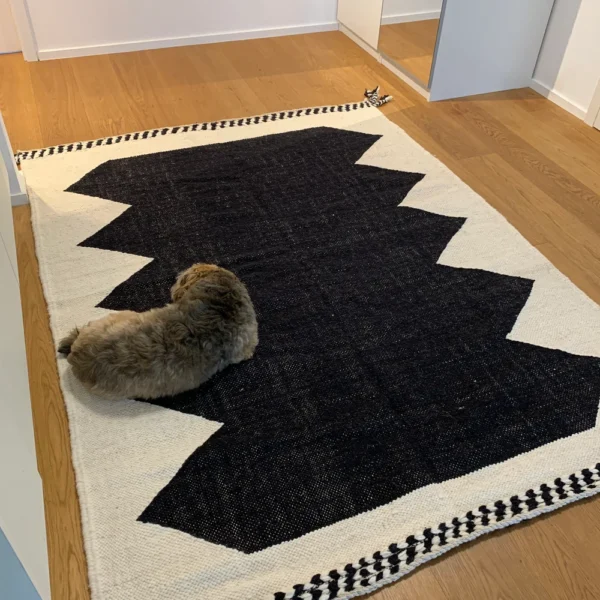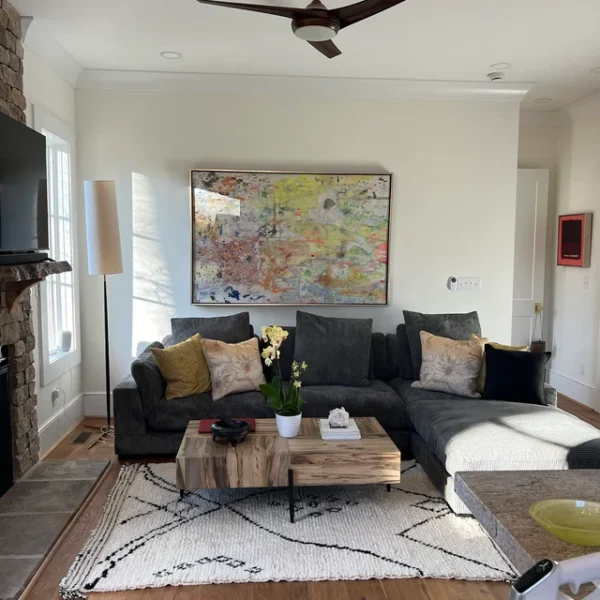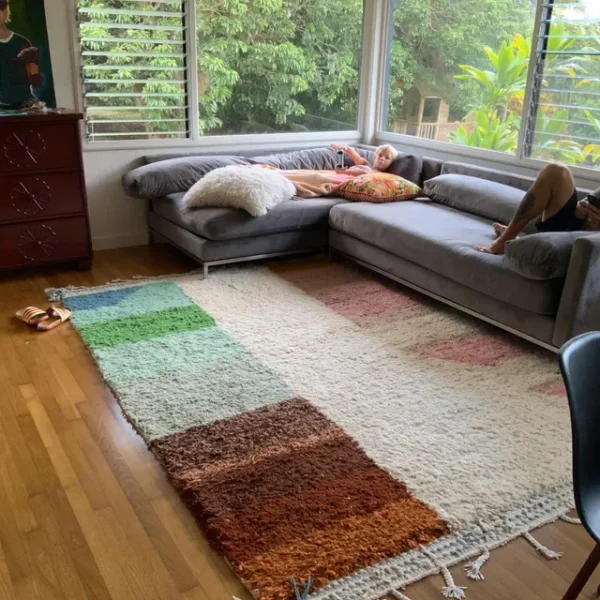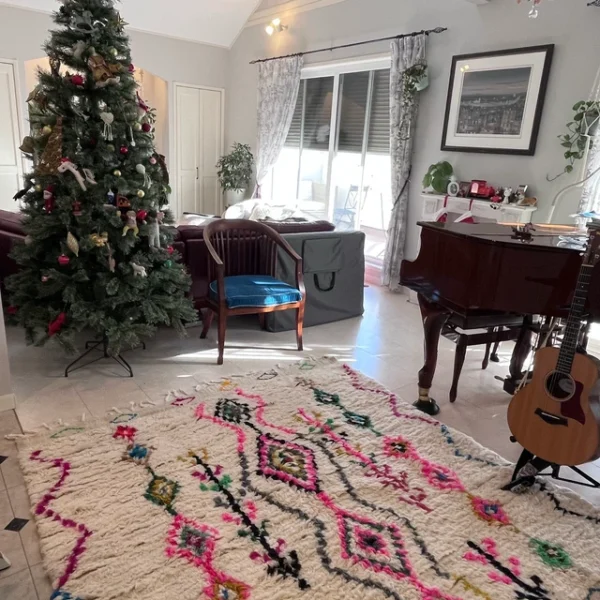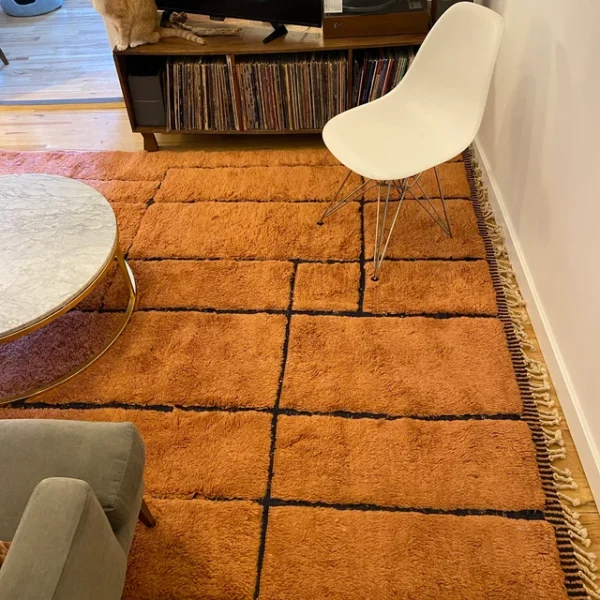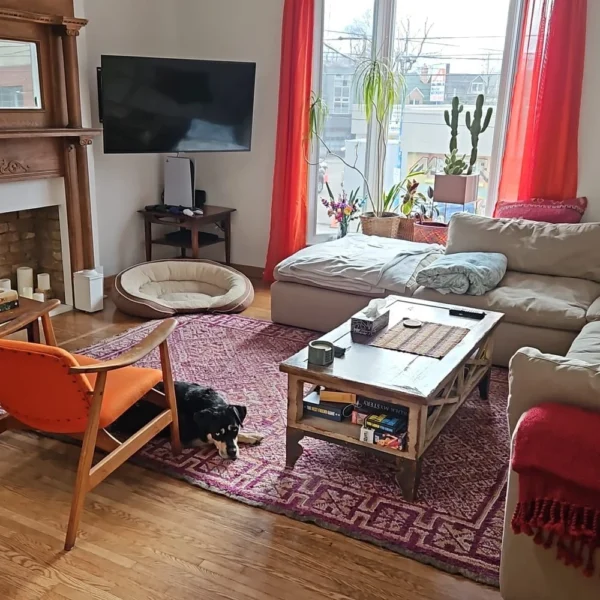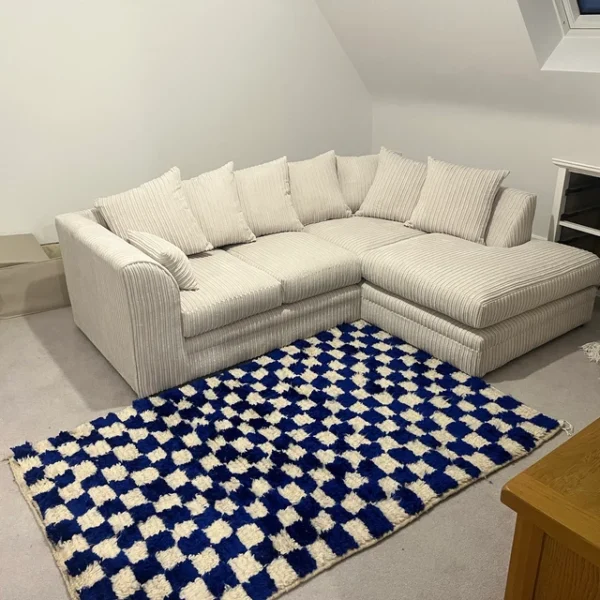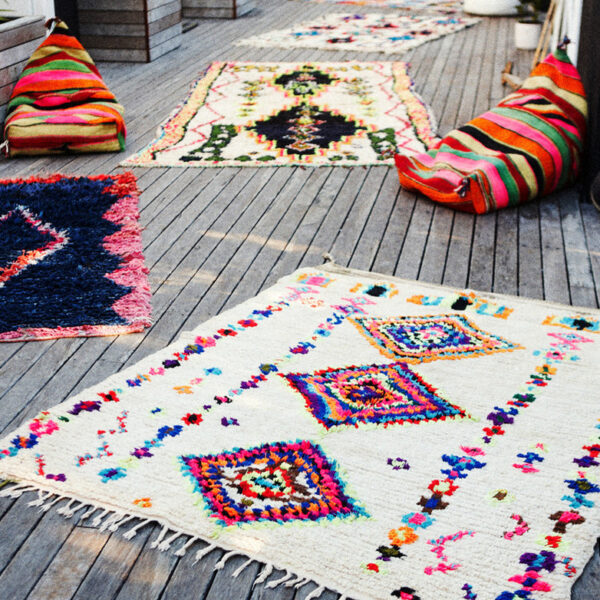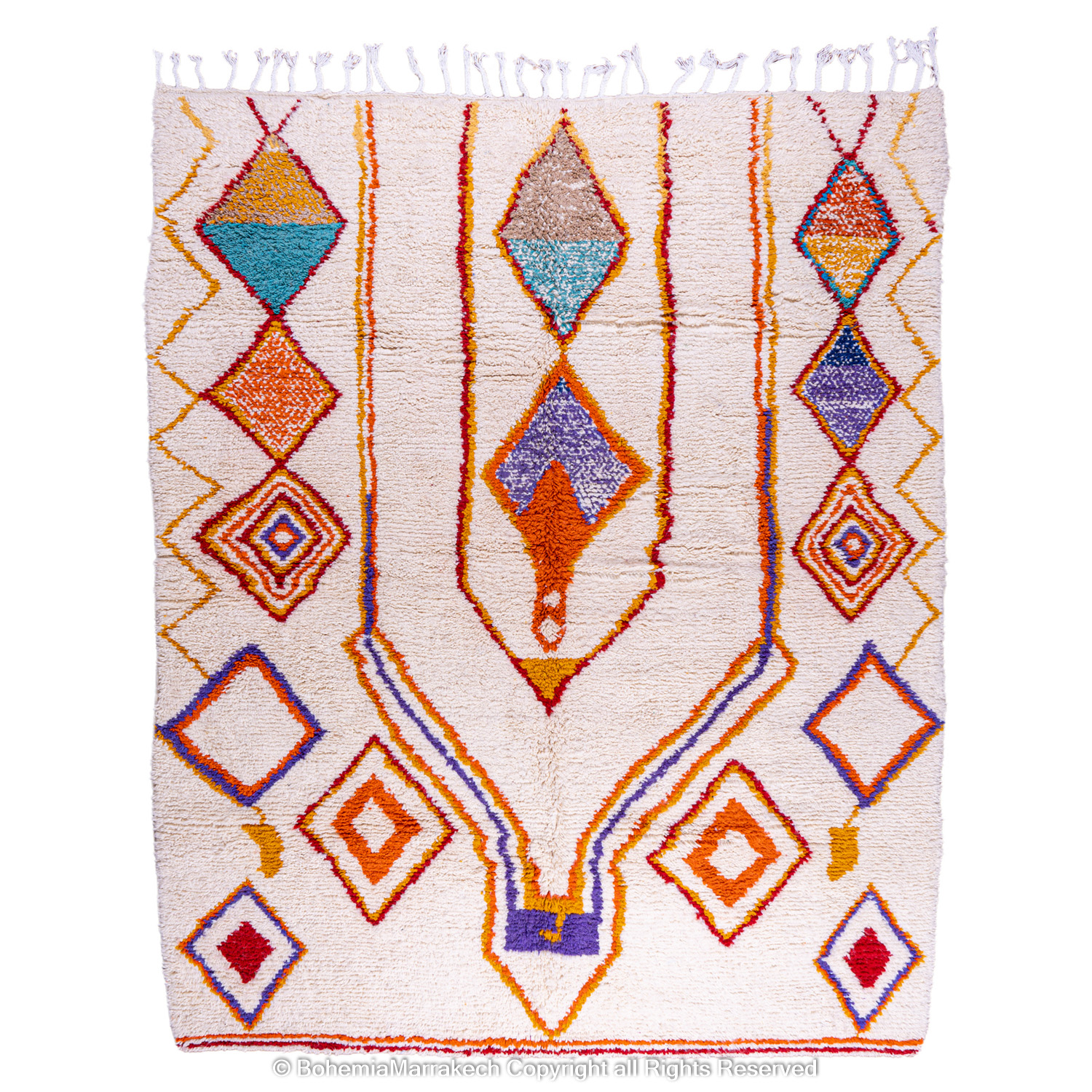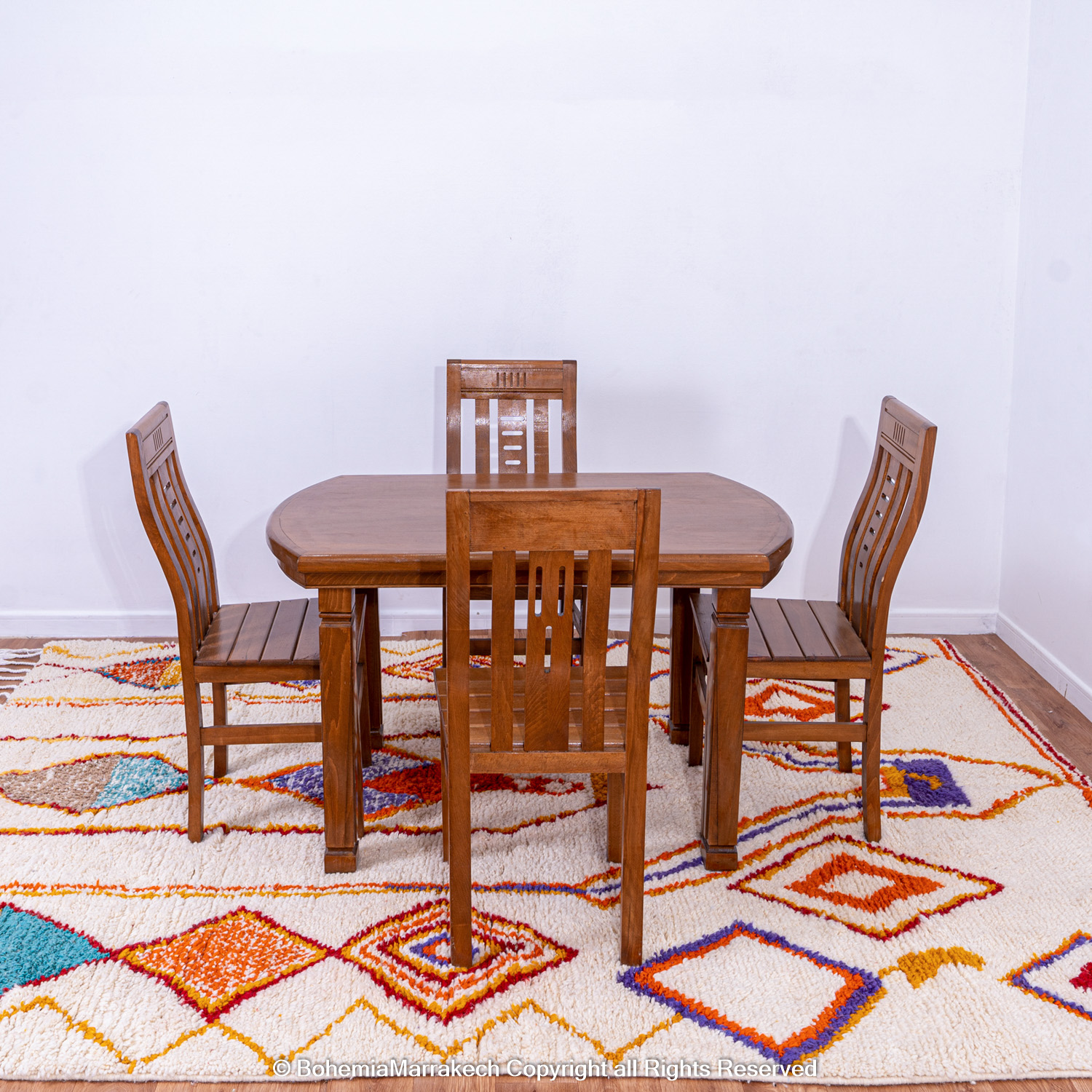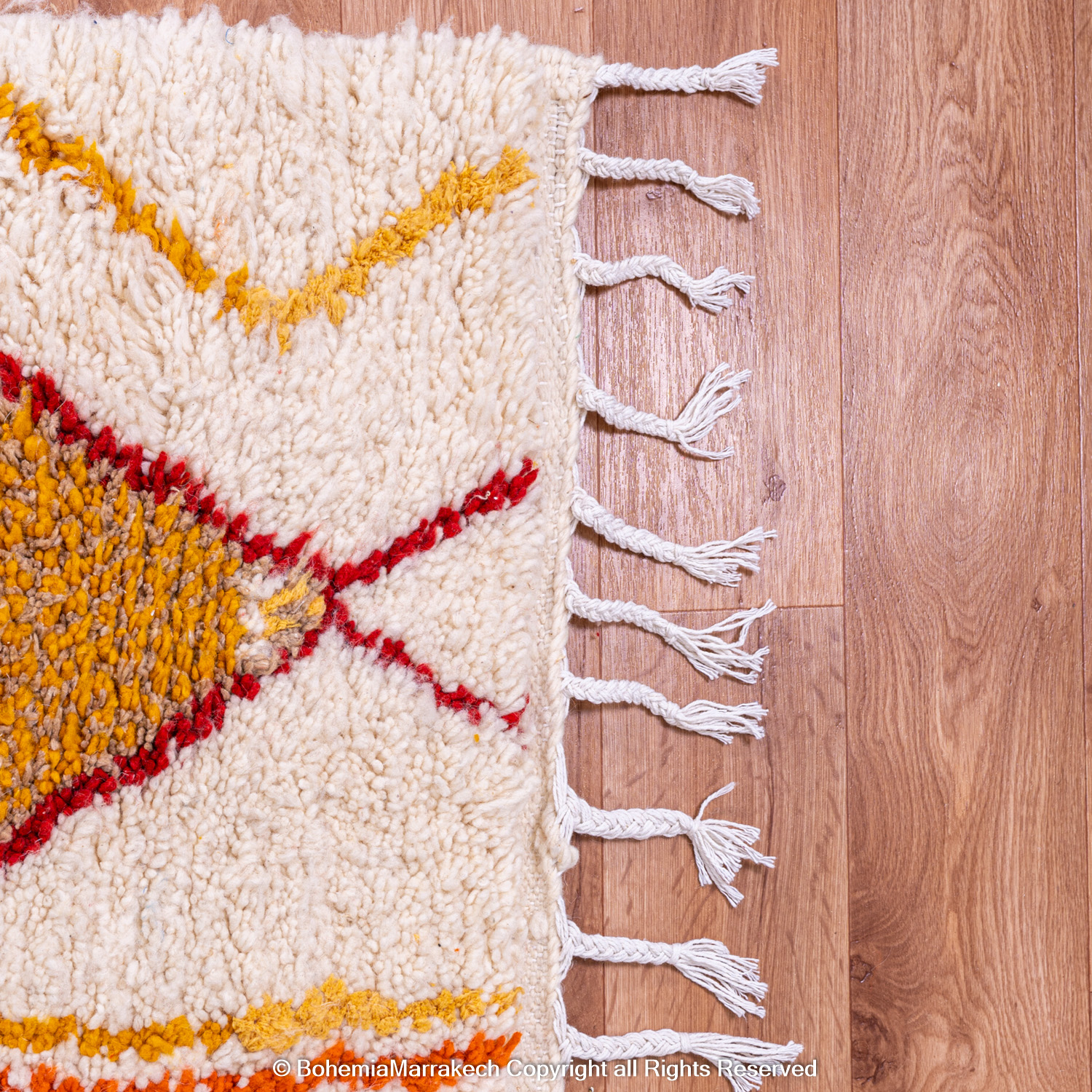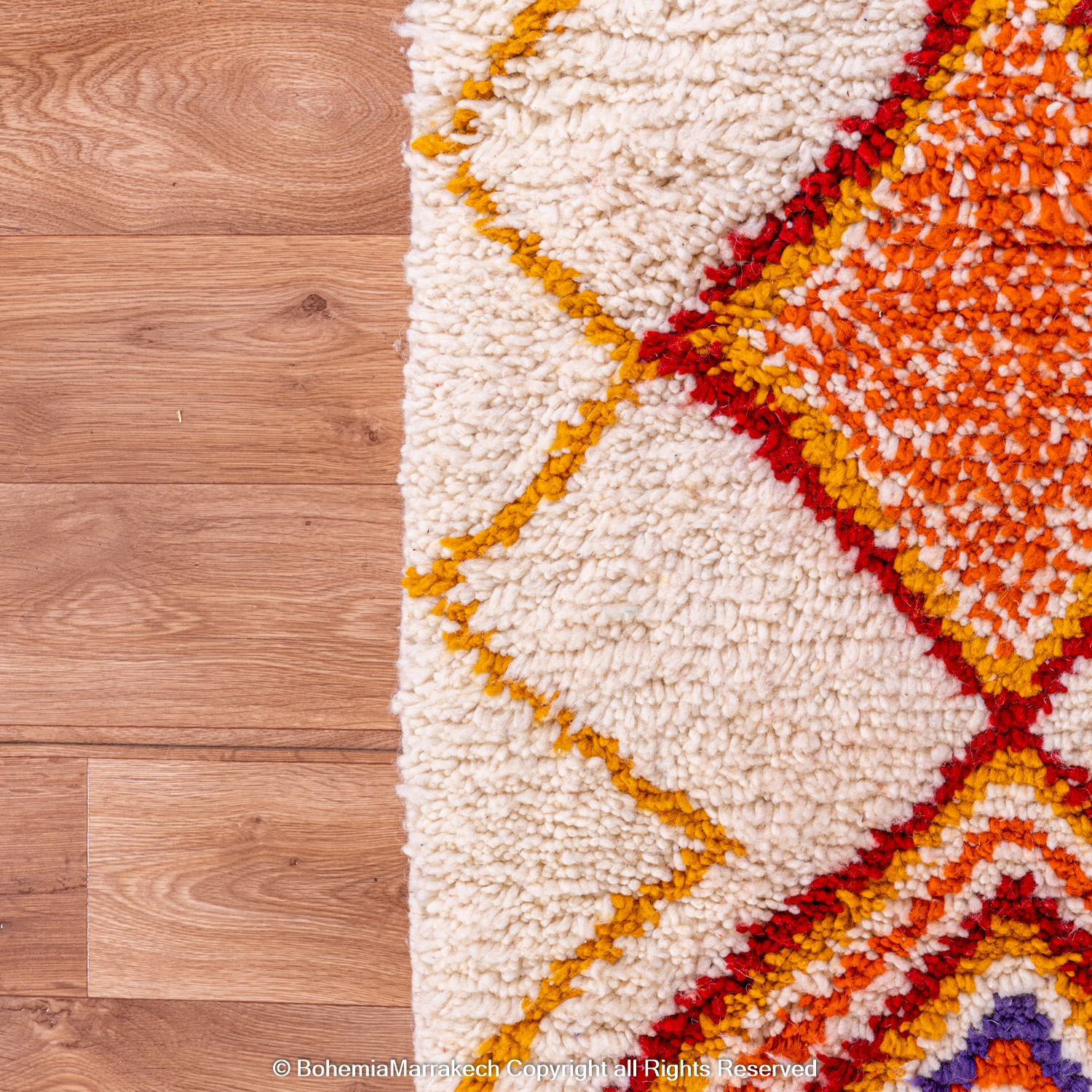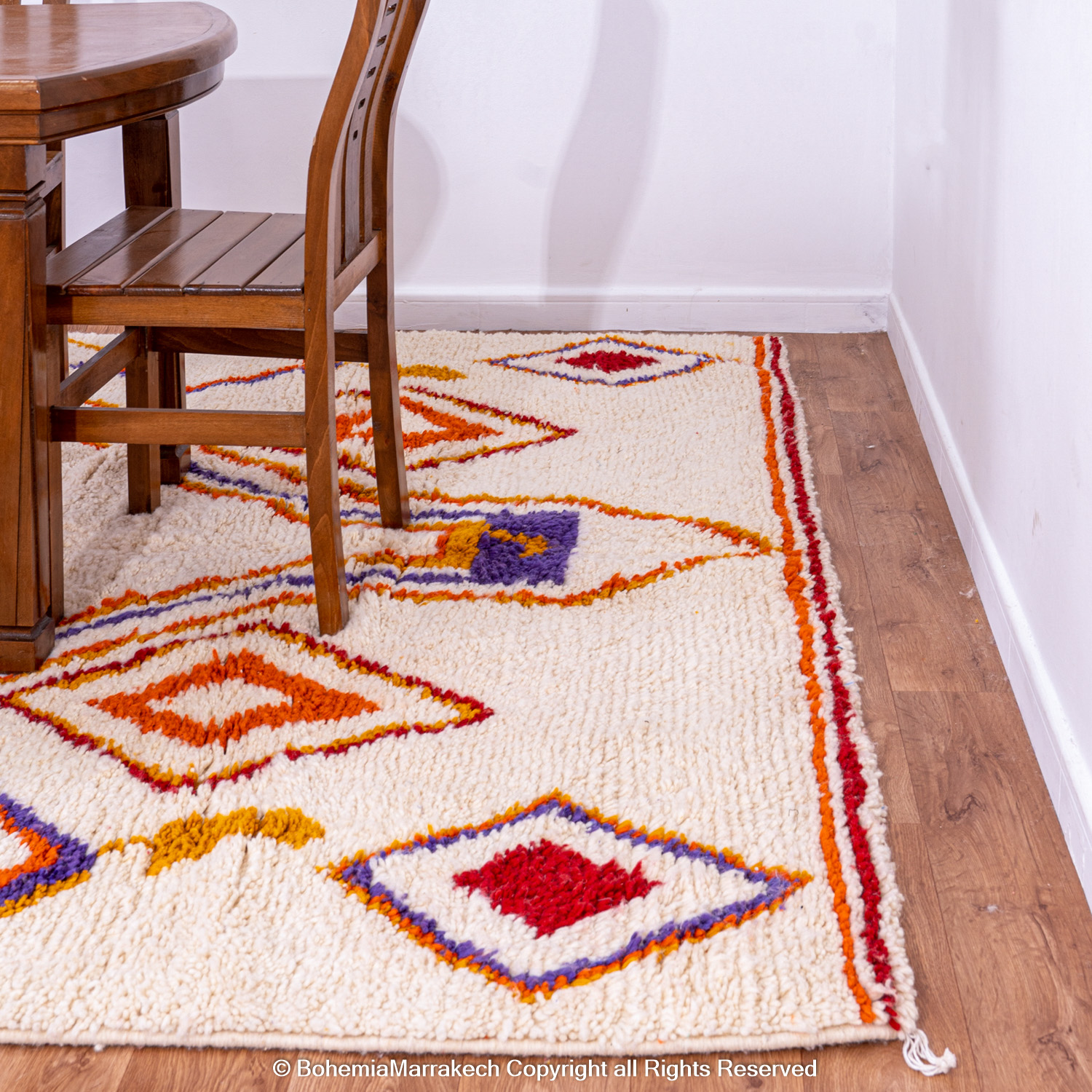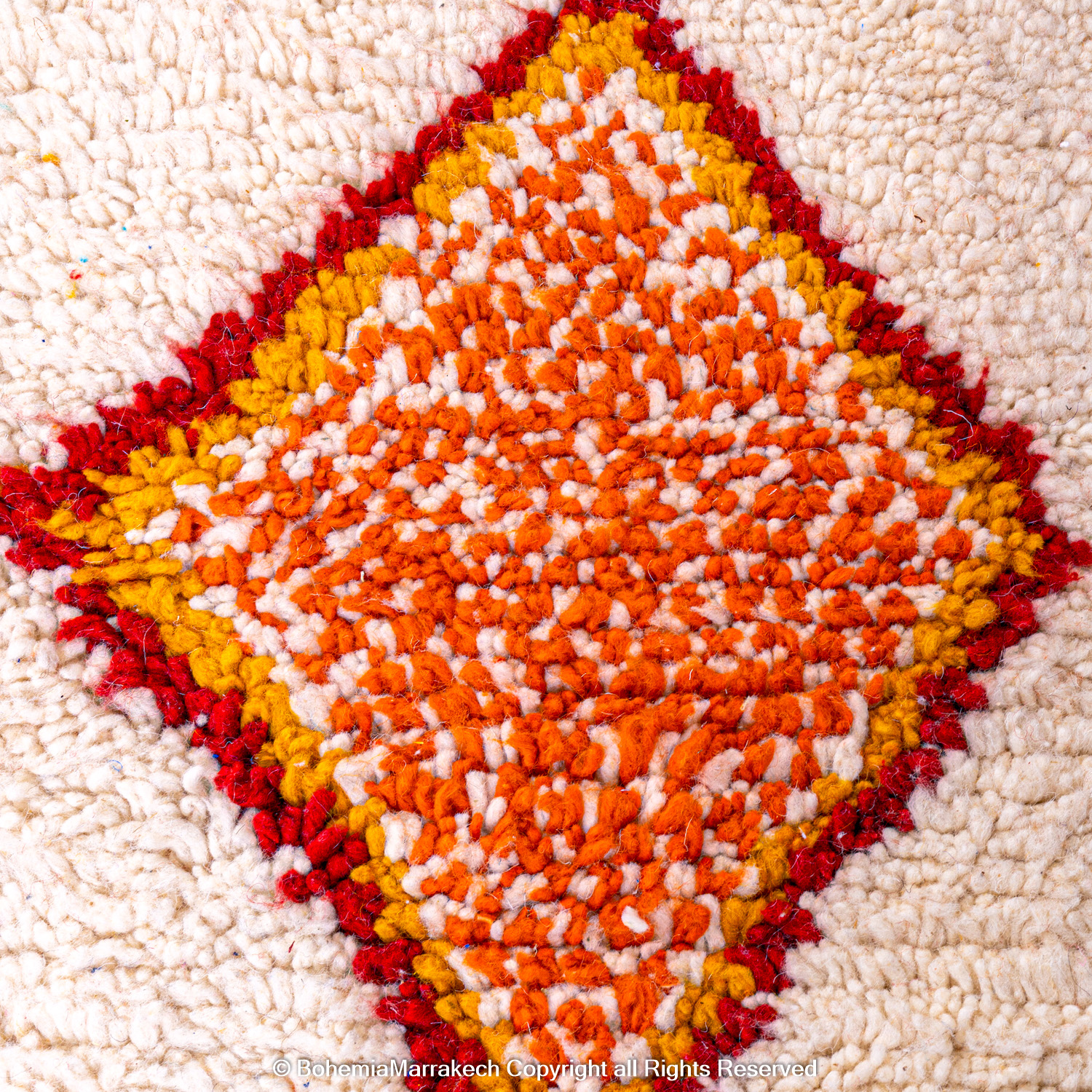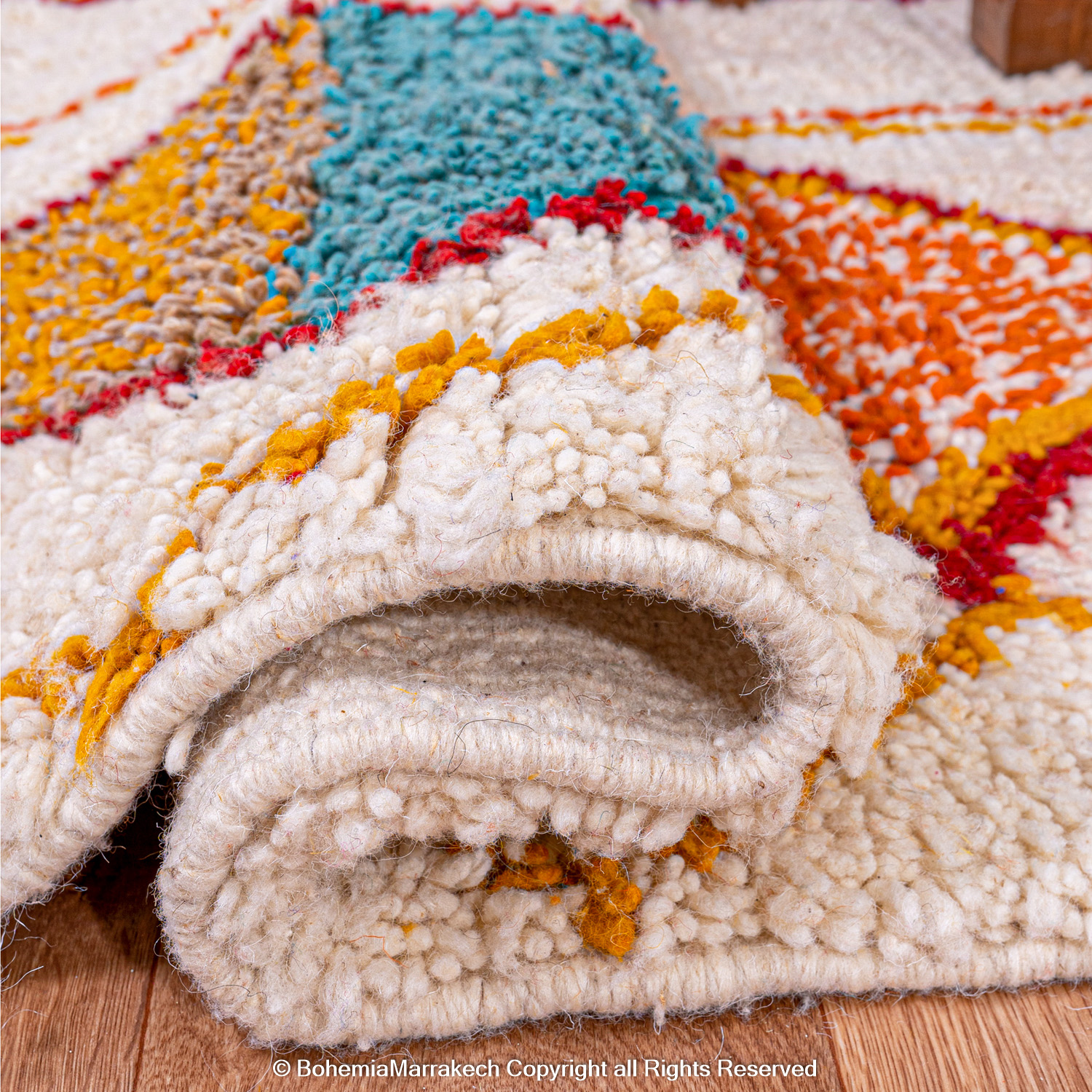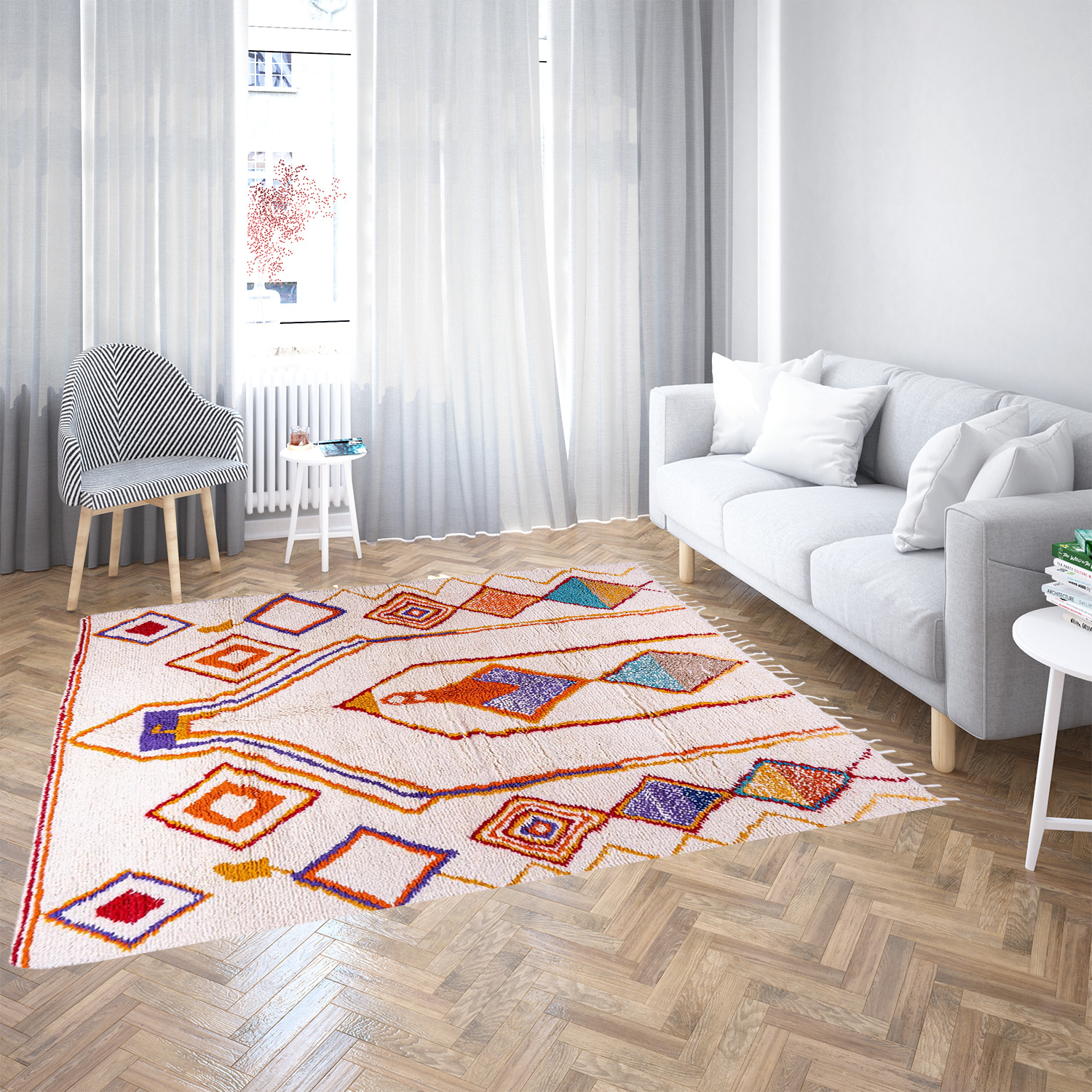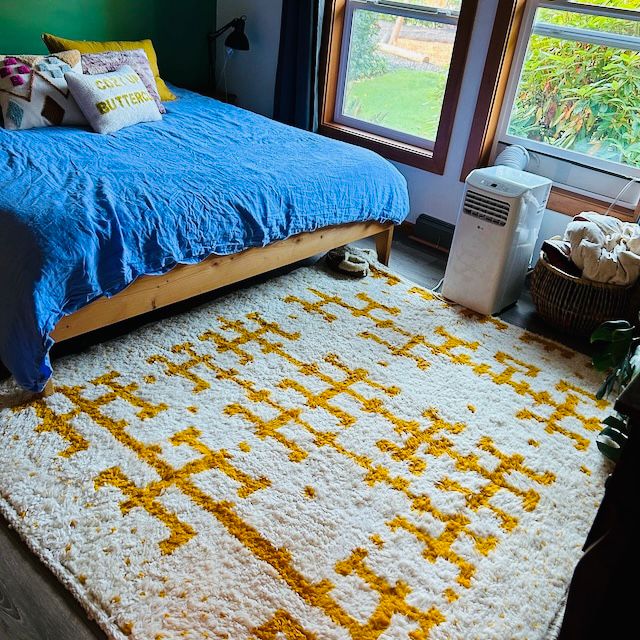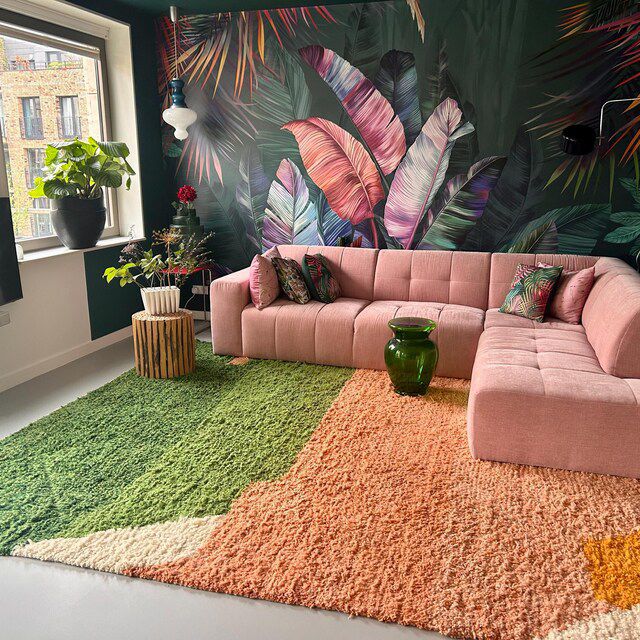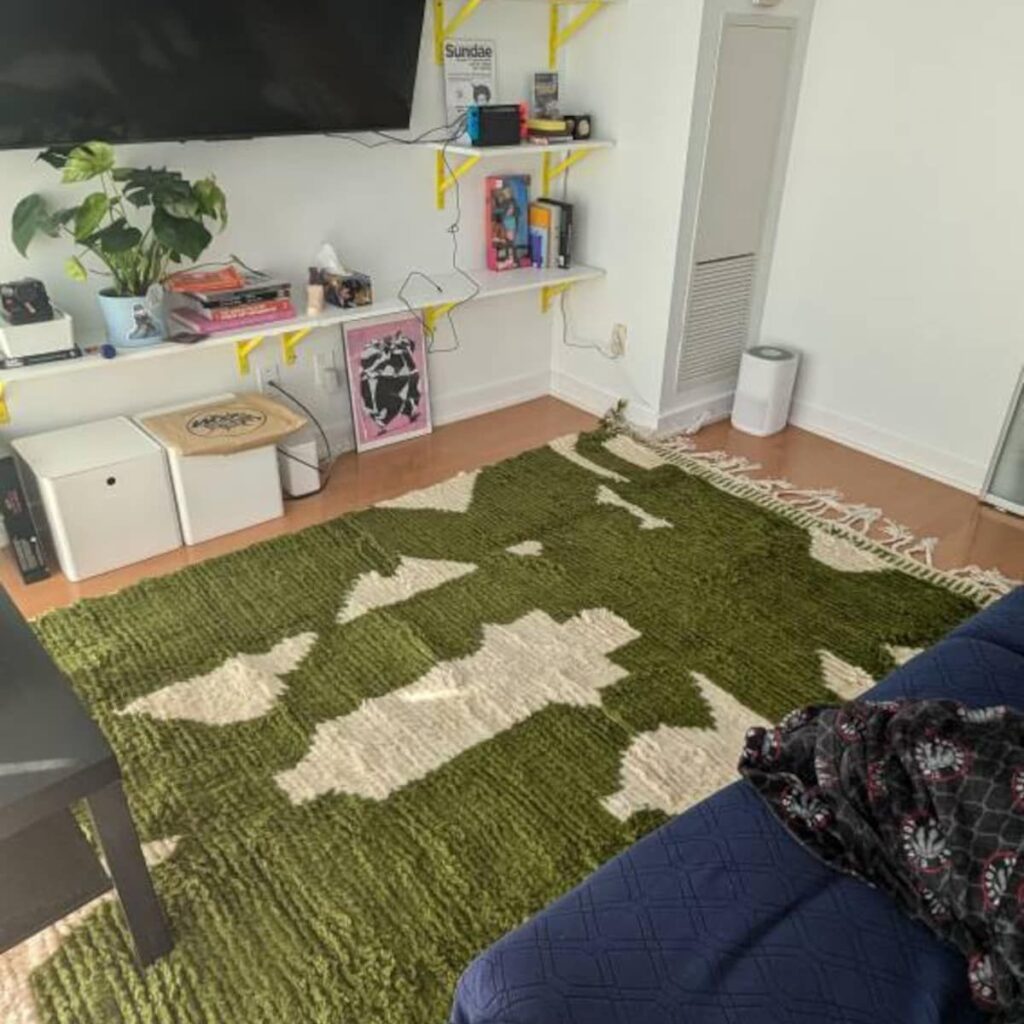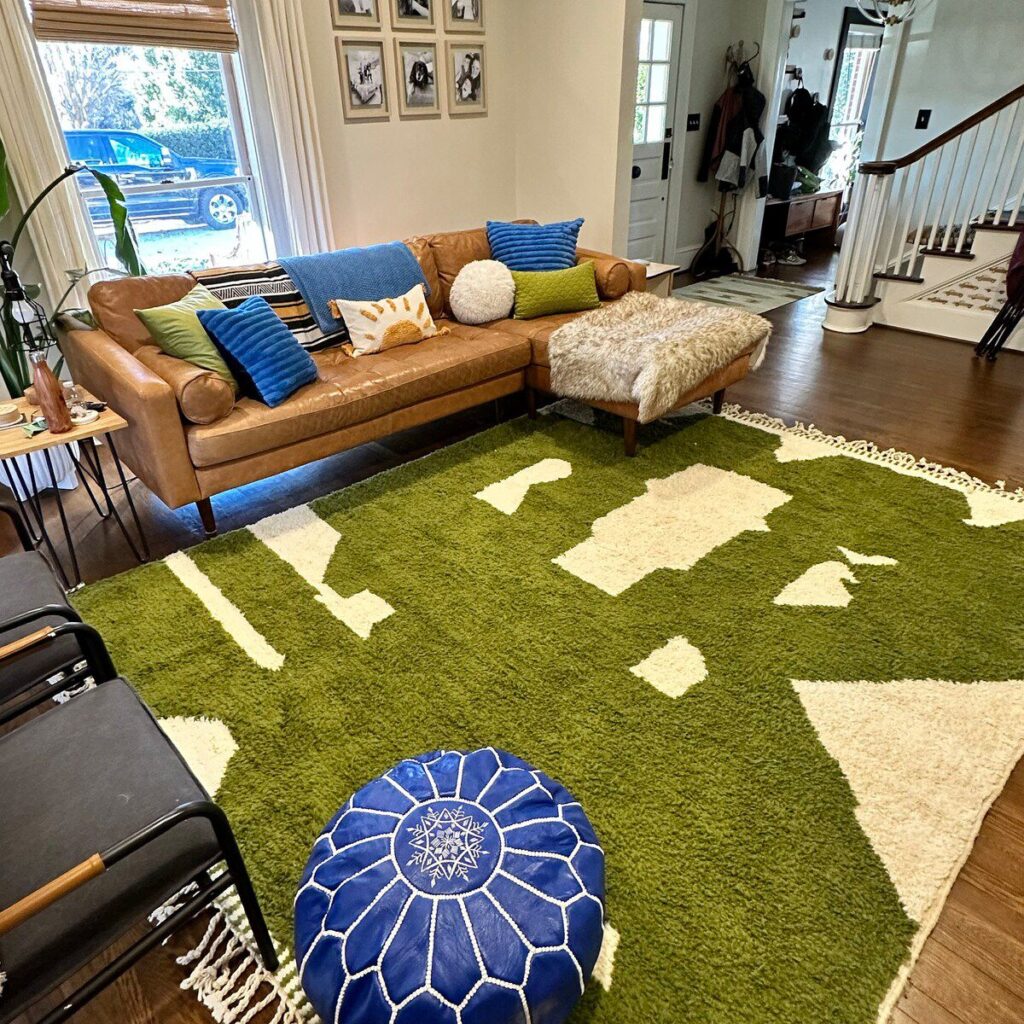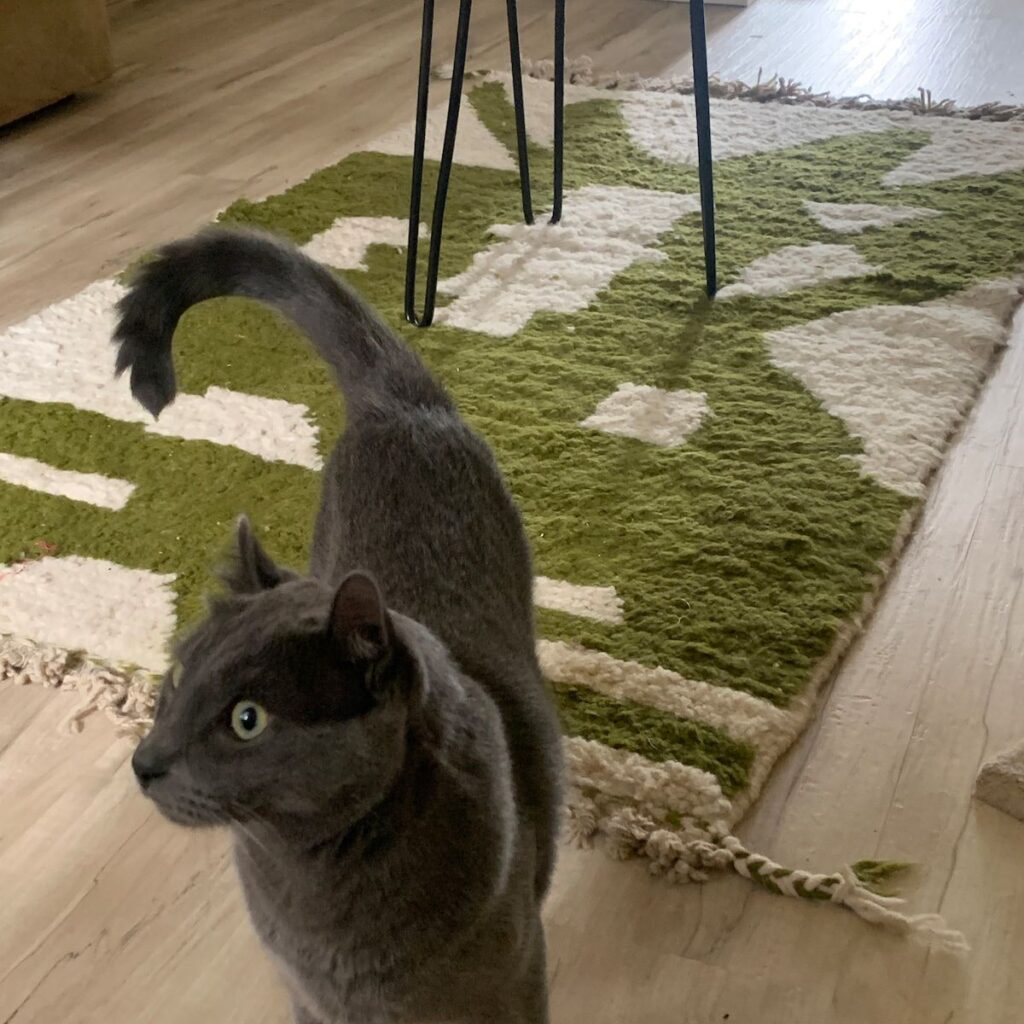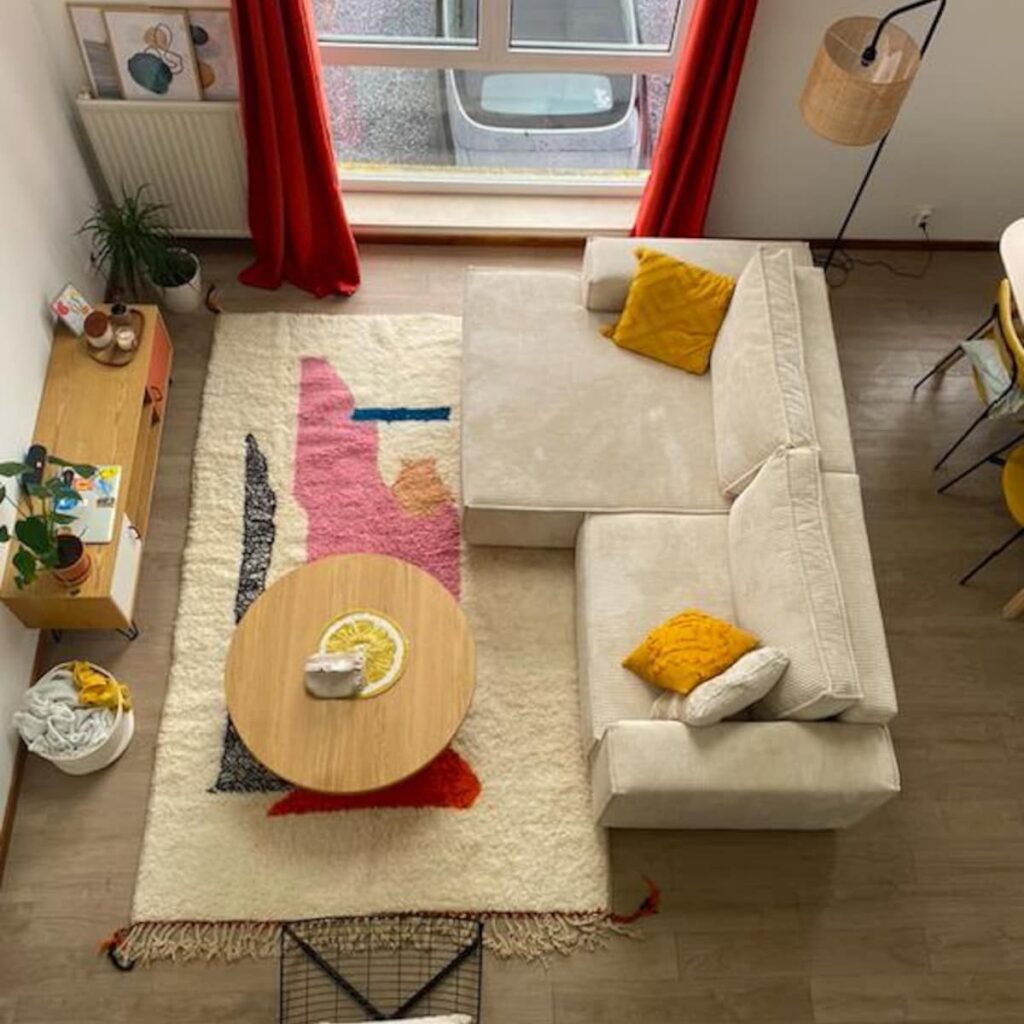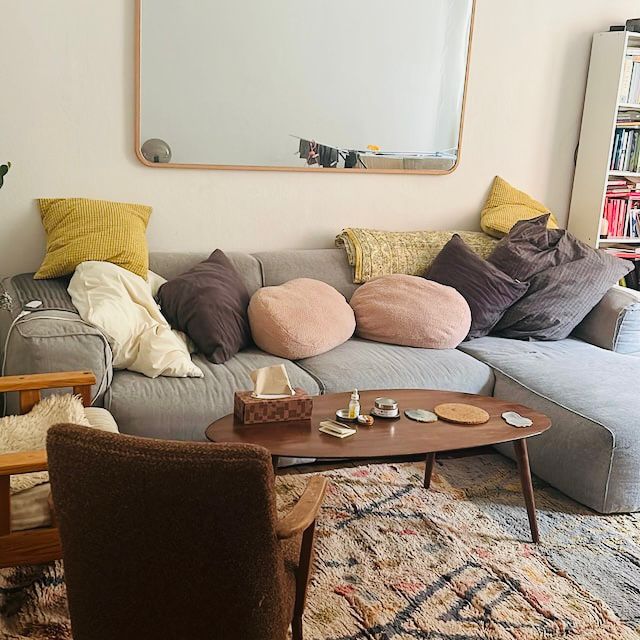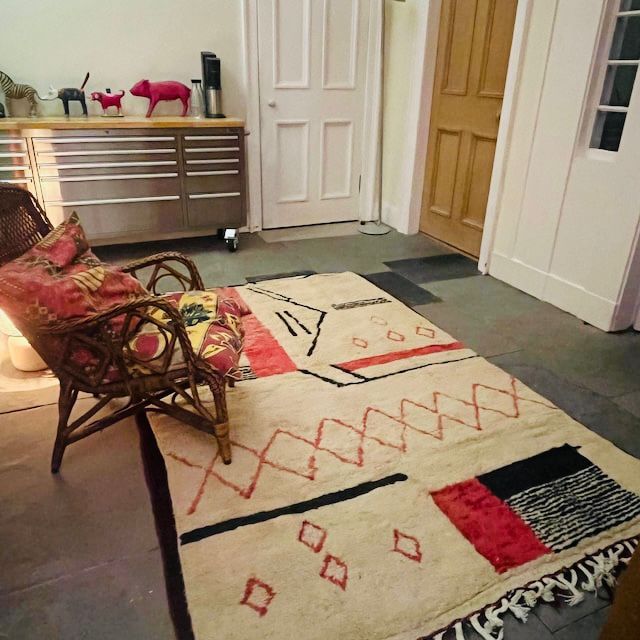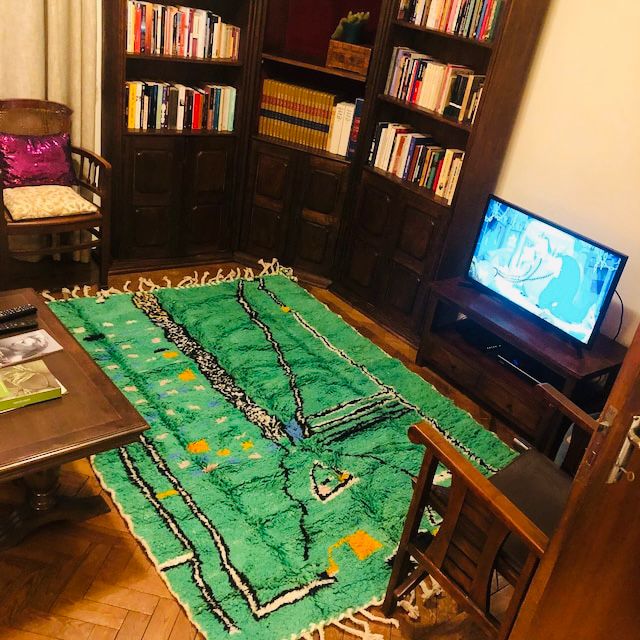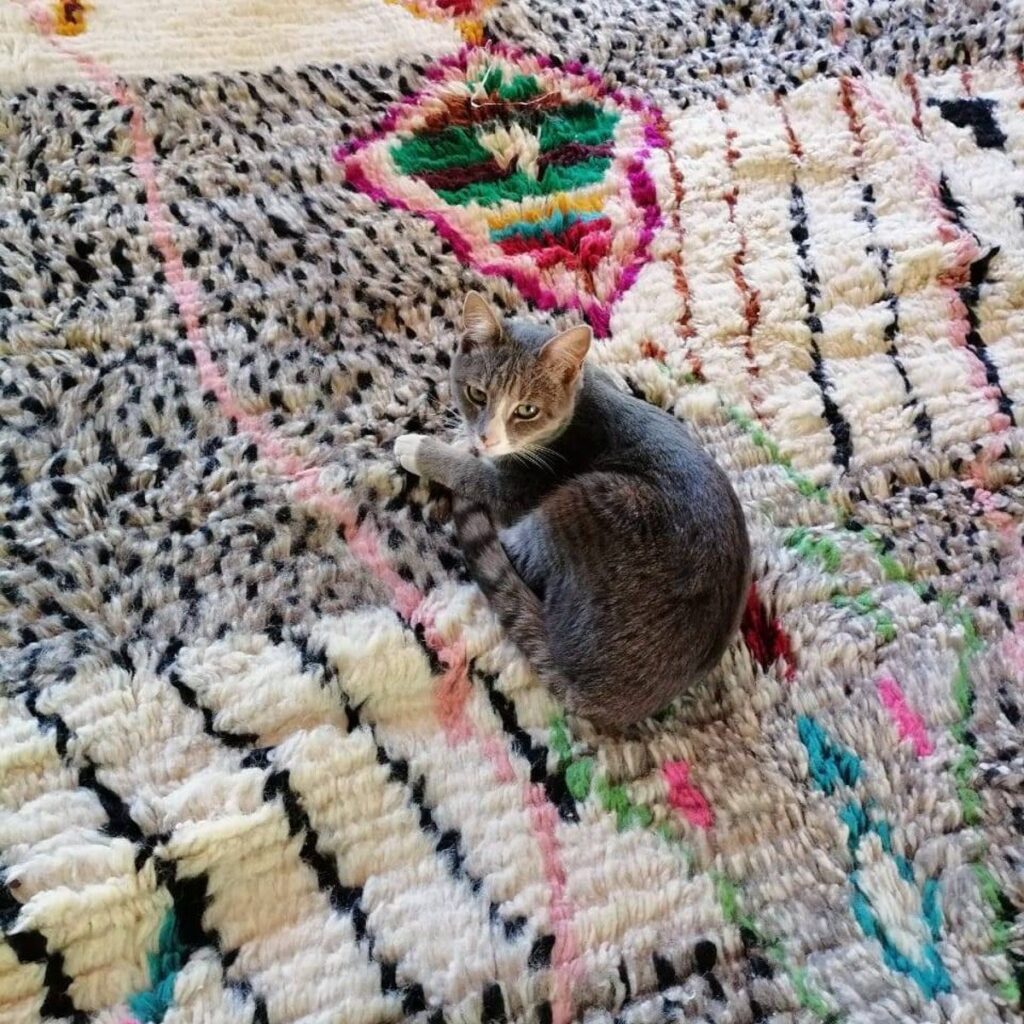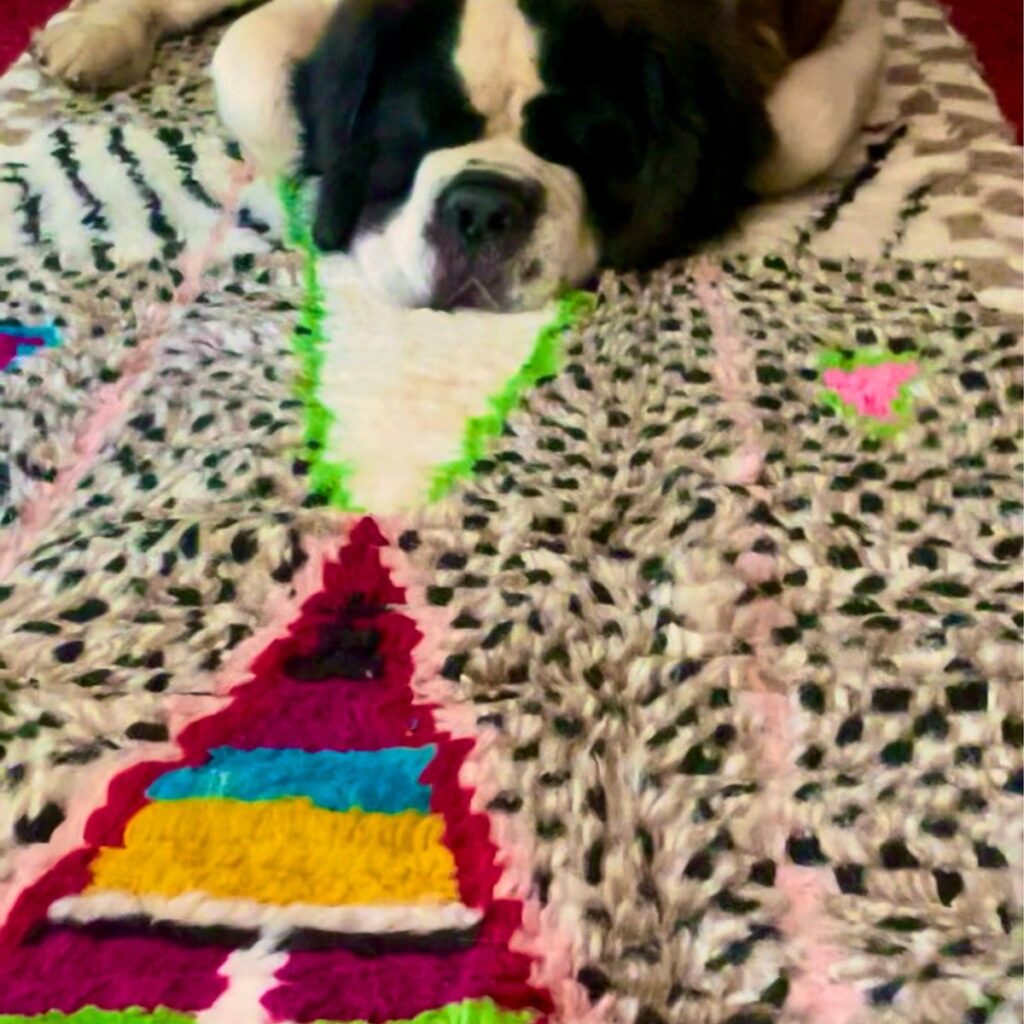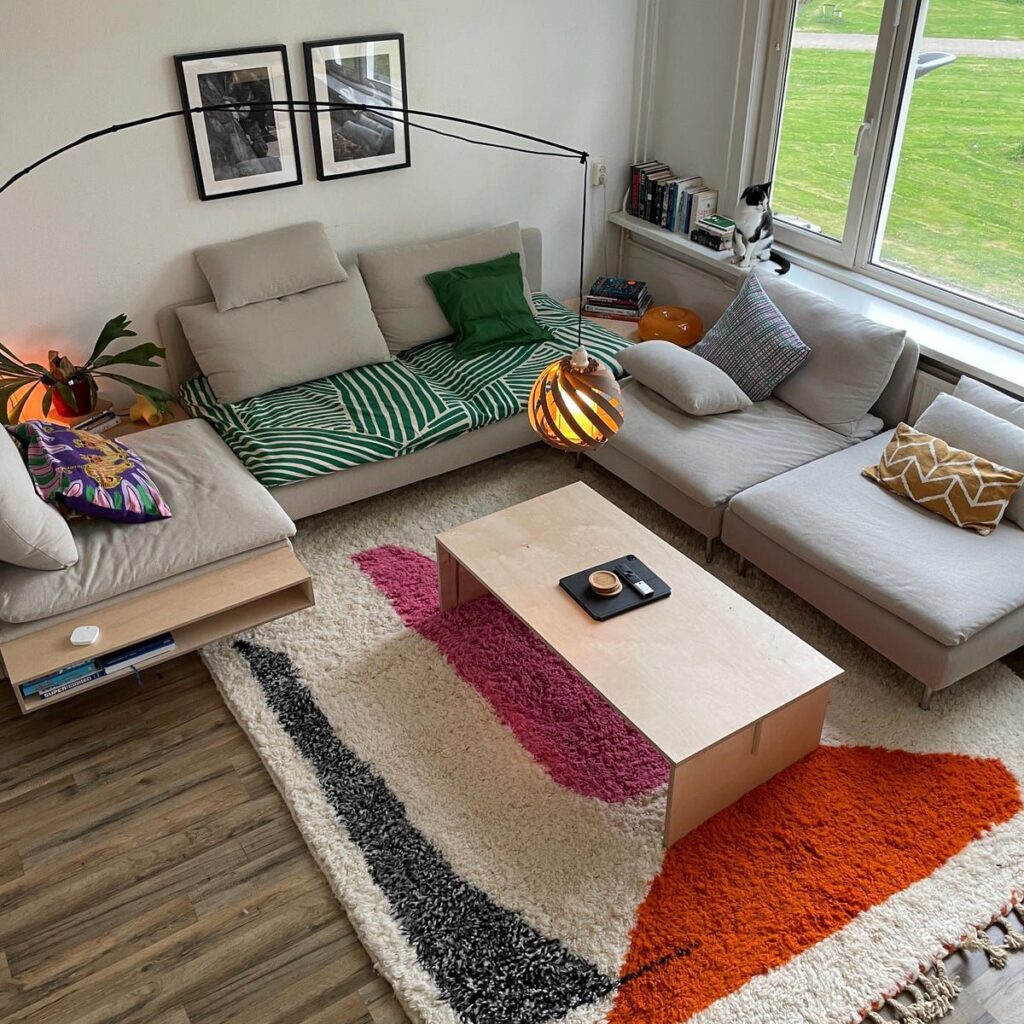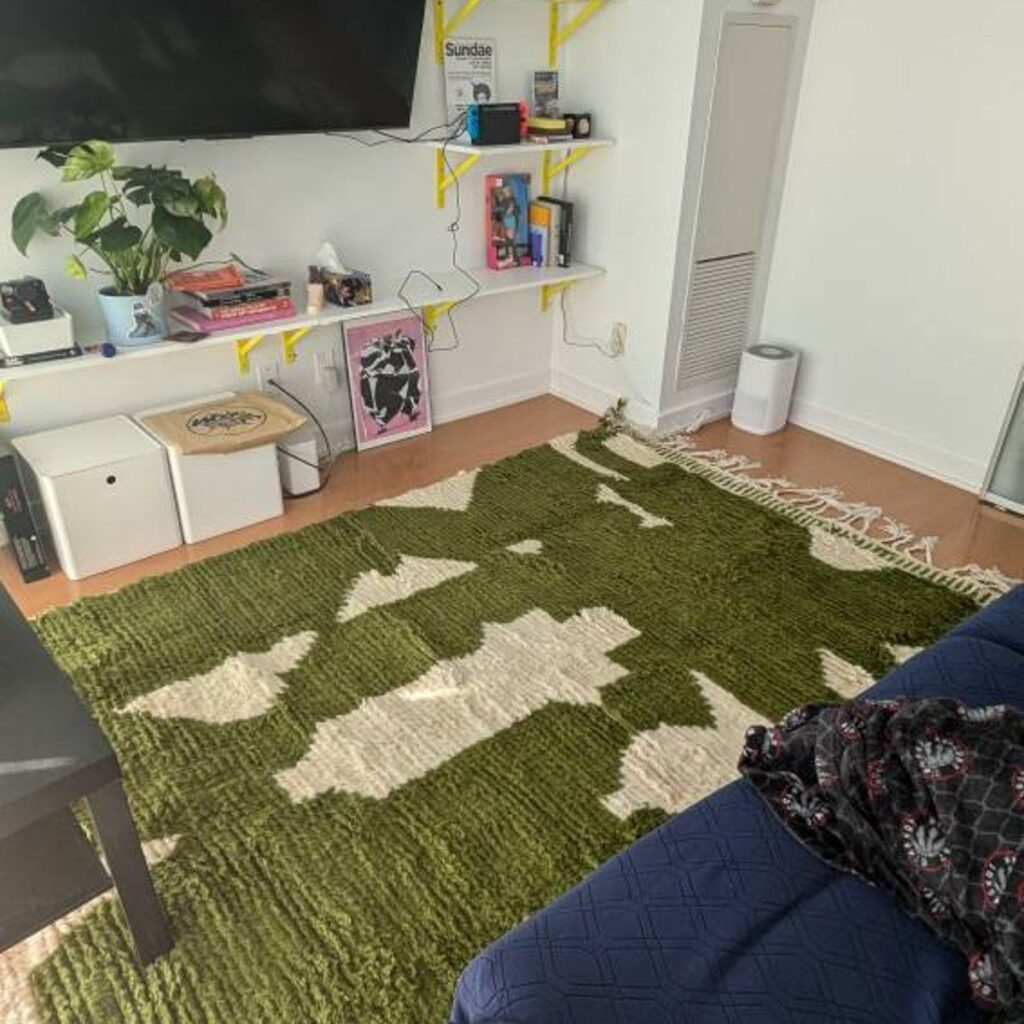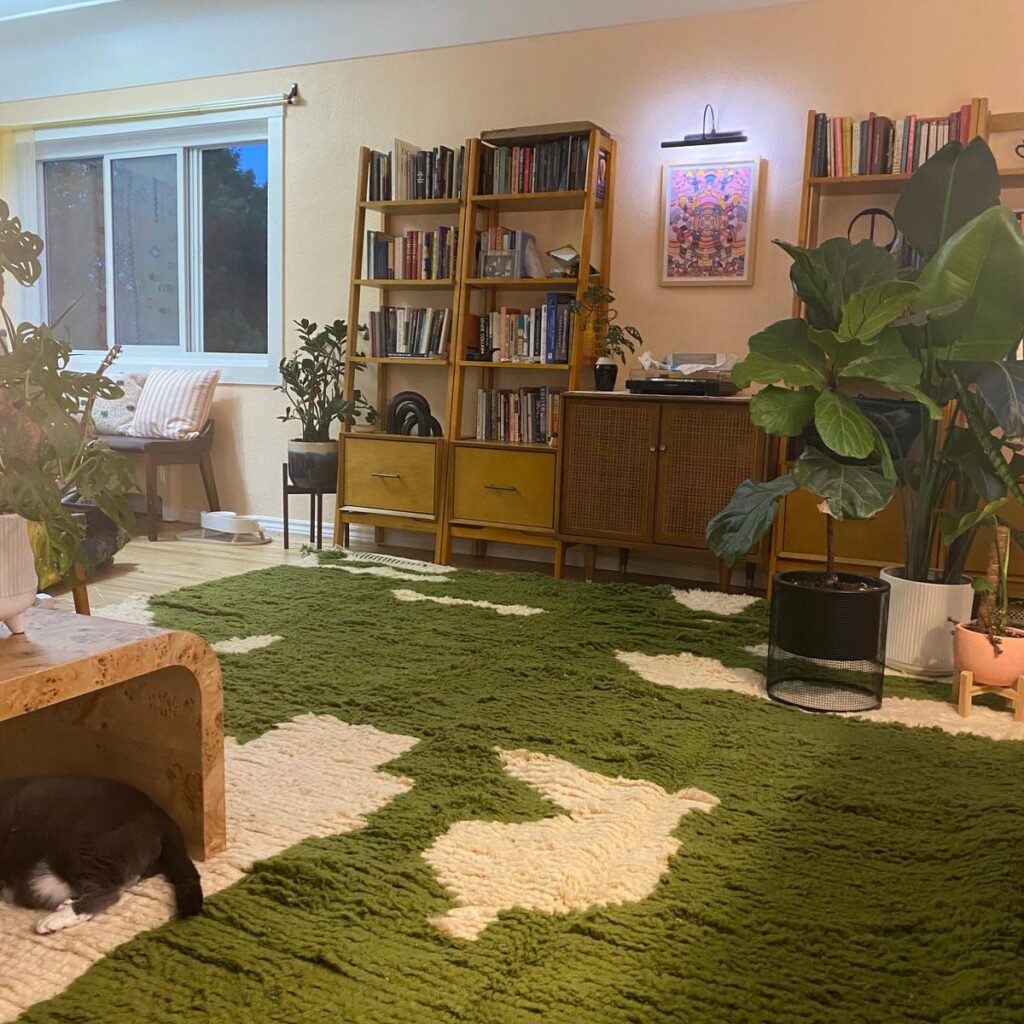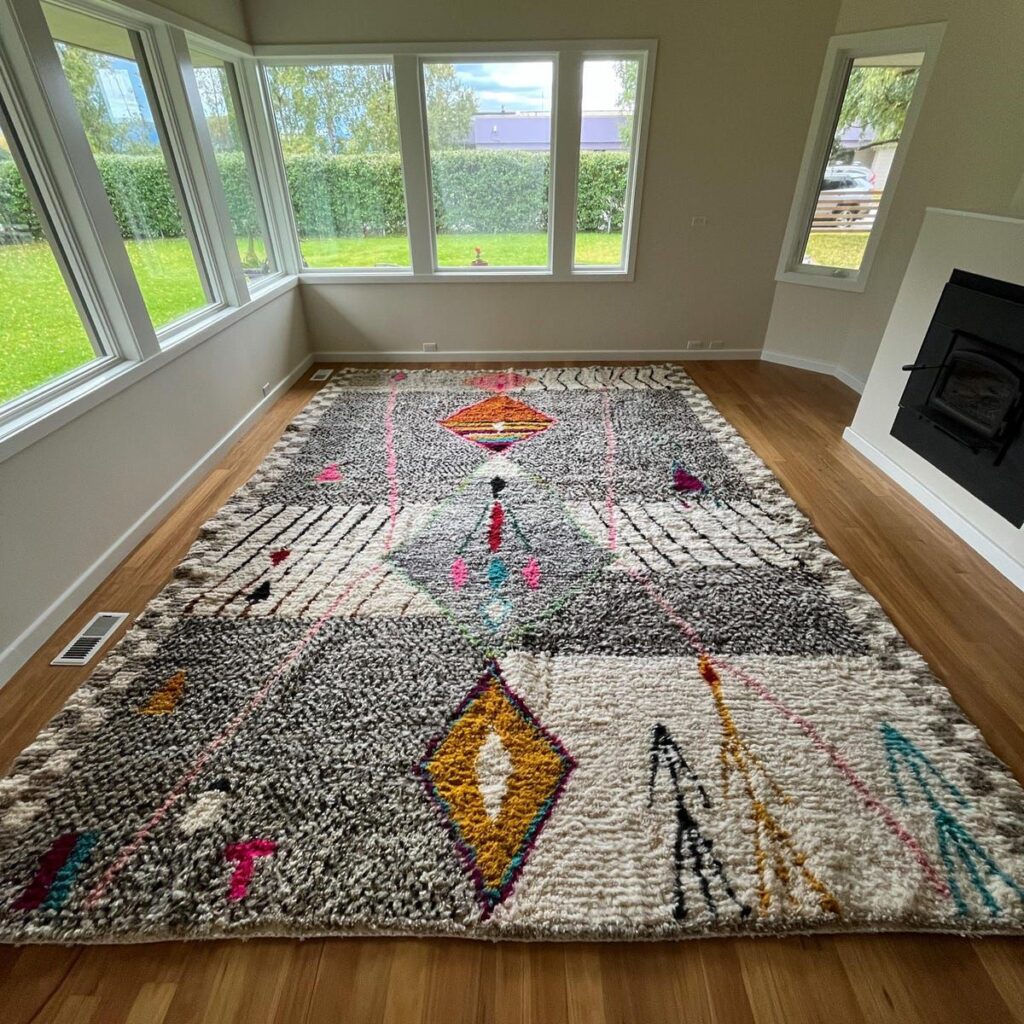Custom Size
Berber Carpet Area Rugs
117,00 $ – 7.020,00 $
46,80 $ – 2.808,00 $
293 reviews
Made to Order | Free Shipping | SAVE UP to 60%
-
🚚 Order today to get by
-
🔄 Returns & exchanges accepted within 30 days
-
✈️ Free shipping
-
📍 Ships from : Morocco
- Secure Checkout SSL Encryption
Authentic
Each rug is intricately handwoven by skilled Moroccan artisans.
High-Quality
Moroccan rugs are typically made from high-quality, natural fibers.
Authentic
Each rug is intricately handwoven by skilled Moroccan artisans.
High-Quality
Moroccan rugs are typically made from high-quality, natural fibers.
BohemiaMarrakech takes proactive measures to neutralize carbon emissions resulting from the shipping and packaging on this purchase.
Delivery Time : 4 -8 Weeks.
Each rug is woven knot by knot, then bathed and air-dried under the serene Moroccan skies.
Your patience will unveil exceptional craftsmanship.
Product Details
Bring the spirit of Morocco to your home with this exquisite rug, handmade by skilled artisans from 100% natural wool. Known for their asymmetrical beauty, Moroccan rugs—also called Amazigh or Berber rugs—offer a unique charm with their abstract, colorful designs and vibrant energy. This rug is handpicked and professionally cleaned by our dedicated team in Morocco, ensuring each piece brings authentic craftsmanship and cultural richness to your space.
The intricate diamond pattern and boho-inspired fringing make it the perfect centerpiece, adding character and warmth to any room, whether a cozy bedroom or an inviting lounge. Designed to blend with various decor styles, this rug invites a touch of adventure into your space.
Why Choose This Rug?
Authentic Amazigh Craftsmanship: Each rug is handcrafted by artisans using traditional weaving techniques passed down through generations.
Luxurious Material: Made from premium wool, this rug offers a soft, comfortable feel underfoot and is built to last.
Enhanced Comfort & Style: Plush pile height and vibrant patterns make it perfect for barefoot comfort and adding personality to your decor.
Shipping & Return
Shipping.
Your order will be delivered via DHL or UPS to your home within 2-8 business days after shipping. We ensure the careful handling and safe delivery of our furniture, fragile and bulky items. For more details on our return policy, click here.
Returns : Returns are accepted for this product. All returns must be postmarked within fourteen (30) days of the delivery date. For more details on our return policy, click here.
Returns : Returns are accepted for this product. All returns must be postmarked within fourteen (30) days of the delivery date. For more details on our return policy, click here.
Product care
Basic Care:
- Follow the Label: Always adhere to the specific care instructions on your rug’s label.
- Rotate Regularly: Rotate your rug every 3-6 months to prevent uneven wear.
- Vacuum Gently: Lightly vacuum once or twice a week on the lightest setting. Avoid powerful vacuums, as they may pull fibers from the rug base. Occasionally vacuum the base as well to keep it fresh.
- Handle Spills with Care: Blot any spills immediately with a paper towel or a colorless cloth—avoid wiping or scrubbing. For spot cleaning, use a small amount of gentle detergent with warm water.
Stain Treatment:
- Act Quickly on Liquid Spills: Blot with paper towels to absorb as much as possible, then clean with a mild shampoo.
- Professional Cleaning: For tough stains or when in doubt, professional dry cleaning is recommended for the best results.
Help or custom request
FAQ'S
Frequently asked questions
About Bohemia Marrakech?
Bohemia Marrakech: A Legacy Woven in Threads
In the bustling and vibrant streets of Marrakech, where the aroma of spices fills the air and the echo of storytellers reverberates, a legacy has been thriving since 1980. Nestled among the colorful stalls and amidst the intricate mosaics, Bohemia Marrakech has been an emblem of Moroccan heritage for over four decades.
Our story began with a simple passion for Moroccan craftsmanship. In 1980, a young enthusiast with an eye for detail and an appreciation for tradition decided to immerse himself in the world of Moroccan rugs. While others saw mere fabrics, he saw stories—stories of nomadic tribes, of age-old traditions, and of Morocco's rich history, all intricately woven into each rug.
As years turned into decades, Bohemia Marrakech flourished, becoming a cornerstone in Marrakech's market. With each rug sold, a part of Morocco's soul found a new home across the world. Our rugs aren't just decor; they're narratives, tales of desert winds and Atlas Mountain snows, of craftsmen and women who've passed down their skills through generations.
2016 marked a monumental year for us. Recognizing the global allure of Moroccan rugs, we embarked on a new journey, bringing our collection online. This allowed lovers of Moroccan artistry worldwide to experience and own a piece of Bohemia Marrakech. Today, our digital store mirrors our physical one, imbued with history, passion, and dedication.
When buyers ask about Bohemia Marrakech, they aren't just inquiring about a store. They're delving into a world where each thread tells a story, where tradition meets modernity, and where a piece of Marrakech can adorn their homes, no matter where they are.
So, as you step into the world of Bohemia Marrakech, remember: you're not just buying a rug. You're becoming a part of a legacy.
Are BohemiaMarrakech rugs good if you have pets?
Yes. BohemiaMarrakech rugs are designed to be pet-friendly! You can easily clean both the Rug Cover and the Rug Pad (see care instructions) and rinse away stains and odors, including pet hair, dirt, slobber, and more. Our Rug Covers are also machine-washable, so you can take them off and put them in your washing machine at home.
Why should I buy my rug from you?
Direct Sourcing: Our direct partnerships with artisans in Morocco ensure that every rug is genuinely handcrafted, ensuring authentic design and quality.
Quality Control: Every rug undergoes a stringent inspection process before being listed for sale, guaranteeing it meets our high standards.
Transparent Pricing: By eliminating middlemen, we provide competitive prices, ensuring you receive value for money.
Supporting Local Artisans: Each purchase directly contributes to the sustainable livelihood of craftsmen in Morocco, ensuring the continuation of this centuries-old craft.
Customer Support: Our dedicated team is always available to provide information, answer queries, and assist with any part of your purchasing process.
In short, when you choose Benisouk, you're choosing transparency, quality, and a commitment to fair trade practices.
How long does shipping take for Moroccan rugs purchased online?
Orders are typically processed and shipped within 24 hours. Once an order has been processed and shipped to you through Expedited Shipping you will receive an email confirmation that contains the tracking number. Shipping takes: between 3 to 5 business days.
Where are Moroccan carpets made?
Moroccan carpets, including popular types like Beni Ourain, Azilal, and Berber rugs, are primarily made by artisans and weavers in various regions of Morocco. These regions are known for their distinctive rug-making traditions and styles. Some of the key areas where Moroccan carpets are made include:
Atlas Mountains: The Atlas Mountains are home to several well-known rug-making regions, including the High Atlas, Middle Atlas, and Anti-Atlas. Each region has its unique style and motifs, with the High Atlas producing bold geometric designs and the Middle Atlas creating rugs with more intricate patterns.
Beni Ourain Region: The Beni Ourain rugs are made by the Beni Ourain tribal people in the Middle Atlas Mountains. These rugs are famous for their minimalist, ivory-colored backgrounds with simple black or brown geometric designs.
Azilal Region: Azilal rugs are crafted by the Berber people in the Azilal region of the High Atlas Mountains. These rugs are celebrated for their vibrant and eclectic designs, featuring a wide range of colors and abstract patterns.
Rabat and Coastal Regions: The coastal cities of Morocco, including Rabat and Casablanca, are known for producing a wide range of traditional Moroccan carpets and textiles. These urban centers have diverse influences, contributing to a variety of rug styles.
Sahara Desert: In the eastern desert and Sahara regions of Morocco, rugs may feature designs influenced by the arid landscape. These designs often incorporate desert elements and nomadic symbolism.
Southwestern Morocco: The southwestern part of Morocco is known for producing rugs with deep reds, blues, and purples. The designs may include diamonds, chevrons, and other geometric patterns, reflecting the region's cultural heritage.
While the specific regions are known for particular rug types and styles, the craft of Moroccan rug making is widespread, and artisans can be found throughout the country. These handmade carpets are an integral part of Moroccan culture, and the craft is often passed down through generations. Each region and tribe has its distinctive weaving techniques, patterns, and motifs, contributing to the diversity and uniqueness of Moroccan carpets.
What are Moroccan Carpet made from?
Moroccan carpets are traditionally made from natural materials, reflecting the rich heritage and sustainable practices of the indigenous Berber people of Morocco. The primary materials used in Moroccan carpet making include:
Wool: Wool is the most common and fundamental material used in Moroccan carpet weaving. It is sourced from local sheep and is highly prized for its qualities, including durability, softness, and insulating properties. Wool is often hand-spun to create textured and lush carpets.
Natural Dyes: Moroccan carpet weavers traditionally use natural dyes made from various plant materials, minerals, and other natural sources to color the wool. These dyes produce a wide range of colors, including earthy tones, vibrant reds, blues, greens, and yellows. The use of natural dyes contributes to the carpets' rich and warm color palettes.
Cotton: While wool is the primary material for the pile (the raised surface of the carpet), cotton is sometimes used to create a strong foundation or warp threads in the carpet. Cotton threads are less elastic than wool, providing stability and structure to the carpet's foundation.
Goat Hair: In some regions of Morocco, particularly in the Sahara Desert, goat hair may be incorporated into the carpet's design. Goat hair is coarser and less soft than wool, and it can be used to add texture or patterns to the carpets.
Synthetics (Modern Usage): While traditional Moroccan carpets are crafted using natural materials, modern Moroccan carpets may incorporate synthetic fibers like nylon or polyester to reduce costs or achieve specific visual effects. However, traditional and authentic Moroccan carpets primarily rely on natural materials.
The choice of materials can vary based on the region, available resources, and the weaver's preferences. The traditional use of natural materials is a central aspect of Moroccan carpet weaving, contributing to the carpets' uniqueness, quality, and connection to the local culture and environment. Natural wool and dyes are prized for their ability to create soft, warm, and environmentally friendly carpets that have made Moroccan carpets highly sought after by collectors and interior designers worldwide.
How are the artisans paid?
It's wonderful to hear about your commitment to the Berber communities and your dedication to upholding fair labor practices. Your statement demonstrates a strong ethical and social responsibility in your approach to the rug-making industry. By ensuring that artisans are fairly compensated and by contributing a substantial portion of your profits to rural community development, you are making a positive impact on the lives of these communities. Providing additional support to artisans further emphasizes your commitment to their well-being, which can be transformative not only financially but also personally for the individuals involved.
This kind of ethical and sustainable business approach not only supports the cultural heritage of the Berber communities but also fosters economic development and social well-being. It's a model that aligns with the principles of fair trade and responsible business practices, and it is likely to resonate positively with customers who appreciate the cultural and social significance of the rugs they purchase.
A significant 20% of our profits directly benefits rural community development, and we provide additional support to our artisans, championing their financial and personal well-being
What makes a rug "vintage"?
A rug is typically considered "vintage" when it is at least 20 years old but less than 100 years old. The term "vintage" is often used to describe items, including rugs, that have a certain age and are from a specific era, but they are not old enough to be classified as "antique."
Here are some key characteristics that define a rug as vintage:
Age: As mentioned, a vintage rug is generally at least 20 years old. It has had time to accumulate wear and develop a certain patina that is valued by collectors and enthusiasts.
Design and Style: Vintage rugs often exhibit design and style elements that were popular during the era in which they were made. These design features can provide insight into the cultural and artistic influences of the time.
Craftsmanship: Vintage rugs are typically handwoven using traditional techniques. The quality of craftsmanship is an important factor in determining the value and desirability of a vintage rug.
Unique Characteristics: Over time, vintage rugs may acquire unique characteristics, such as variations in color due to fading or wear, imperfections, and irregularities that contribute to their charm and character.
Historical and Cultural Significance: Some vintage rugs are associated with specific regions, tribes, or historical periods. They may carry cultural or symbolic meanings that add to their significance.
Rarity: Vintage rugs can become increasingly rare as they age. Finding a well-preserved vintage rug from a specific era or region can make it highly sought after by collectors.
It's important to note that the definition of "vintage" can vary in different contexts and industries. In the world of rug collecting and sales, the 20-year threshold is commonly used. However, in other contexts, such as vintage fashion or vintage cars, the criteria may differ.
How does it feel to step on this wool rug?
Stepping on a wool rug can be a delightful and luxurious experience. The feel of a wool rug underfoot is characterized by several notable qualities:
Softness: Wool is known for its natural softness and warmth. When you step on a wool rug, it provides a cozy and comfortable sensation that can be especially pleasing, particularly in colder months.
Plushness: Wool rugs often have a thick and plush pile, which gives them a cushioned feel underfoot. This plushness adds to the comfort and can make walking or standing on the rug very pleasant.
Resilience: Wool fibers have a natural springiness, which means that the rug can quickly bounce back to its original shape after being compressed. This resilience contributes to a supportive and comfortable experience when walking on the rug.
Warmth: Wool is an excellent insulator, so wool rugs feel warm, making them especially welcoming in cooler environments. The temperature-regulating properties of wool can help keep your feet warm during the winter and cool during the summer.
Durability: Wool is a durable material, so a wool rug is designed to withstand everyday wear and foot traffic. This durability ensures that the rug maintains its comfort and appearance over time.
Texture: The texture of a wool rug can vary depending on the specific weaving or knotting techniques used. Some wool rugs have a smoother texture, while others may have a more textured surface, providing a tactile element to the experience.
Natural Feel: Wool is a natural material, which means that stepping on a wool rug can evoke a connection to nature. This natural feel can be grounding and soothing.
Overall, the feel of a wool rug underfoot is often described as plush, soft, and comforting. It provides a sense of warmth and luxury, making it a popular choice for areas in the home where comfort and style are priorities, such as living rooms, bedrooms, and cozy sitting areas.
What sets handmade rugs apart from machine-made ones?
Handmade rugs and machine-made rugs differ in several significant ways, including craftsmanship, quality, uniqueness, and value. Here are some key factors that set handmade rugs apart from machine-made ones:
Craftsmanship: Handmade rugs are crafted by skilled artisans who use traditional techniques, often passed down through generations. The entire weaving process, from spinning the yarn to knotting the rug, is done by hand. Machine-made rugs, on the other hand, are manufactured by automated machines, with minimal human involvement in the production process.
Quality: Handmade rugs are known for their superior quality. Artisans take great care in selecting materials, hand-knotting the rugs, and paying attention to every detail. This results in durable, long-lasting rugs that often become family heirlooms. Machine-made rugs, while more affordable, are generally of lower quality and have a shorter lifespan.
Uniqueness: Handmade rugs are one-of-a-kind works of art. Each rug has its distinct design, color palette, and characteristics. Artisans infuse their creativity and cultural influences into their creations, making each handmade rug unique. Machine-made rugs are mass-produced, so they lack the individuality and character of handmade rugs.
Materials: Handmade rugs often use high-quality natural materials like wool or silk. These materials provide a luxurious texture, warmth, and durability. Machine-made rugs may use synthetic fibers or lower-quality materials, which can result in a less appealing look and feel.
Value: Handmade rugs are considered valuable investments due to their craftsmanship, uniqueness, and durability. They tend to appreciate in value over time, making them a sought-after choice for collectors. Machine-made rugs are typically more affordable but do not have the same investment potential.
Tradition and Culture: Handmade rugs often reflect the cultural heritage and artistic traditions of the communities where they are made. They carry a sense of history and authenticity. Machine-made rugs lack this cultural connection.
Labor and Fair Wages: Handmade rug production supports artisan communities and provides employment opportunities. When artisans are fairly compensated for their work, it contributes to the economic well-being of these communities. In contrast, machine-made rugs are typically produced in large factories with minimal labor costs.
Eco-Friendly: Handmade rugs are often considered more eco-friendly because they use natural, sustainable materials and traditional techniques. Machine-made rugs may involve the use of synthetic materials and processes that can be harmful to the environment.
While machine-made rugs have their place in the market and offer affordability, handmade rugs are highly regarded for their quality, craftsmanship, and cultural significance. Their uniqueness and individuality make them a valuable addition to interior spaces, reflecting a deep connection to tradition and artistry.
Are these rugs safe for babies?
The safety of Moroccan rugs or any type of rug for babies depends on several factors, including the materials used, the rug's construction, and maintenance practices. Here are some considerations to ensure the safety of Moroccan rugs for babies:
Materials: Moroccan rugs can be made from a variety of materials, with wool being a common choice. Wool is generally considered safe for babies as it is a natural and non-toxic material. It is also known for its durability and resistance to staining.
Dyes: When purchasing a Moroccan rug, consider the type of dyes used for coloring. Natural, plant-based dyes are generally safe and eco-friendly. Ensure that any synthetic dyes used are non-toxic and do not contain harmful chemicals.
Allergies: Some babies may be sensitive to wool or other materials used in rugs. If your baby has allergies or sensitivities, it's essential to choose rugs made from hypoallergenic materials.
Maintenance: Proper cleaning and maintenance are crucial for rug safety. Ensure that the rug is regularly cleaned to remove dust, dirt, and allergens. Use non-toxic, baby-safe cleaning products if necessary.
Rug Padding: Placing a non-slip rug pad underneath the Moroccan rug can help prevent it from slipping or sliding, reducing the risk of accidents.
Rug Thickness: Consider the thickness of the rug. Thicker rugs may provide additional cushioning, which can be beneficial for babies who are learning to crawl or walk. However, make sure there are no tripping hazards.
Supervision: Always supervise your baby when they are on or near a rug. Babies can sometimes put small rug fibers or fringe in their mouths, which can pose a choking hazard.
Ventilation: Ensure that the room where the rug is placed is well-ventilated to reduce the risk of allergens or dust buildup.
Safety Standards: Check if the rug meets any safety standards or certifications, especially if you have concerns about materials or dyes used.
Ultimately, the safety of a Moroccan rug for your baby will depend on the specific rug, your baby's needs and sensitivities, and your maintenance practices. If you have specific concerns or if your baby has allergies or sensitivities, it's a good idea to consult with a pediatrician or allergist to ensure that the rug is safe for your baby. Additionally, choose rugs that are easy to clean and maintain, and consider using playmats or rugs designed specifically for babies during playtime and tummy time.
How do I care for my rug?
Caring for your rug, including Moroccan and Berber rugs, is essential to maintain its beauty and prolong its lifespan. Here are some general tips for rug care:
Regular Vacuuming: Vacuum your rug regularly to remove dust, dirt, and debris. Use a vacuum cleaner with a brushless suction head to avoid damaging the fibers. Be gentle when vacuuming the rug's fringe, if applicable, to prevent fraying.
Rotate Your Rug: To ensure even wear, rotate your rug periodically. This helps prevent excessive wear in high-traffic areas.
Spot Cleaning: Address spills and stains promptly. Blot (do not rub) the area with a clean, absorbent cloth to soak up the liquid. Then, use a mixture of mild soap and water to gently clean the stained area. Rinse with clean water and blot dry. Avoid using harsh chemicals or bleach, as they can damage the rug's colors and fibers.
Professional Cleaning: Consider professional rug cleaning every one to three years, depending on usage. Look for a rug cleaning service with experience in cleaning delicate handmade rugs, and be sure to mention the rug's specific materials and construction.
Protect from Sunlight: Direct sunlight can cause colors to fade over time. If possible, place your rug in a location that is not exposed to direct sunlight for extended periods.
Rug Padding: Use a rug pad underneath your rug to prevent it from slipping or sliding. A rug pad also adds cushioning and protects the rug from wear caused by foot traffic.
Prevent Moth Damage: Wool rugs are susceptible to moth damage. To prevent moths, keep your rug clean, and store it in a well-ventilated area. You can also use natural moth repellents or cedar blocks in your storage space.
Avoid Moisture: Keep your rug away from excessive moisture or humidity, as it can lead to mold or mildew growth. If your rug gets wet, allow it to dry completely in a well-ventilated area.
Regular Inspection: Periodically inspect your rug for any signs of wear, damage, or loose threads. Address any issues promptly to prevent further damage.
Roll for Storage: If you need to store your rug, roll it rather than folding it to avoid creases and wrinkles. Store it in a cool, dry place with good ventilation.
Use Anti-Slip Mat: If your rug is placed on hard flooring, consider using an anti-slip rug mat to prevent movement and protect the floor underneath.
Remember that the specific care requirements for your rug may vary based on the materials and construction. It's always a good idea to follow any care instructions provided by the rug manufacturer or seller. Additionally, if you have concerns about cleaning or maintaining a valuable or delicate rug, consulting a professional rug cleaner or conservator is recommended.
Are these rugs handmade?
Berber rugs, as the name suggests, are traditionally handmade by the Berber people of Morocco. These rugs are known for their craftsmanship, unique designs, and cultural significance. The Berber community has a rich tradition of handweaving rugs, and many of the Berber rugs produced in Morocco are crafted using traditional techniques that have been passed down through generations.
Why do handmade rugs sometimes have imperfections?
Handmade rugs reflect the artisan's touch, with each piece having unique variations. These imperfections signify genuine craftsmanship, making every rug one-of-a-kind.
What sizes do vintage rugs come in?
Vintage rugs come in a variety of sizes, from small accent pieces to large area coverings. Each rug's dimensions reflect its unique creation and the artisan's design intent.
Do the colors of the rugs look exactly as they appear online?
The accuracy of the colors of Moroccan rugs (or any other product) when viewed online can vary depending on several factors. Here are some considerations to keep in mind:
Device Display: The appearance of colors can differ based on the screen or device you are using to view the rug online. Monitors, smartphones, and tablets may not display colors with complete accuracy.
Lighting: The lighting conditions under which you view the rug online can affect how the colors appear. Natural light, artificial light, and the color temperature of the light source can all impact your perception of the colors.
Photography: The quality of the images and the accuracy of the photographs used to represent the rug can influence how the colors are perceived. Professional photography can provide a more accurate representation, but differences may still exist.
Dye Lots: In some cases, slight variations in the dye lots used in rug production can result in differences in color. This is a common occurrence with handmade rugs, and it can add to the uniqueness of each piece.
Monitor Calibration: The color settings on your monitor or device may not be calibrated perfectly, leading to variations in how colors are displayed.
To get a better sense of the actual colors of a Moroccan rug, it's advisable to:
- Read the product description and any color descriptions provided by the seller or manufacturer.
- Request additional photos or information from the seller if you have concerns about color accuracy.
- Consider that some variations in color are expected and are often a part of the charm of handmade and vintage rugs.
If the precise color of the rug is crucial to your decision, you might explore options to view the rug in person or inquire about the seller's return policy in case the colors do not meet your expectations.
Can I return or exchange my rug?
Yes, we have a 30 days return policy. If you're not satisfied with your purchase, please contact our customer service, and they will guide you through the return process.
How long will it take to get my custom rug from the moment I order?
Orders are processed within 24 hours, and sent straight to our weavers who start making your custom piece right away if it’s not available in stock. The whole process—from shearing, spinning, and dying the wool to weaving, washing, and transporting the rug—takes roughly 4 to 8 weeks. In the winter months, the drying process takes a bit longer, so please allow an additional 1-2 weeks for delivery.
Do vintage Moroccan rugs come with any information about their history or origin?
We provide as much information as possible about the rugs in our collection, including their approximate age and origin, allowing you to appreciate their history.
How do you ensure quality rugs?
We’ve done years of research and partner with only the most talented artisans who have been making rugs for generations. The quality of our rugs is what we’re most proud of! Check what our clients say about us.
H
H.P. This is my second purchase from this company. The quality, value, and customer service are terrific. The owner was very nice about accommodating a custom adjustment as well.
R
R.D. Great communication and a beautifully handcrafted Beni rug at an affordable price. Pile is not as low as I expected - it’s slightly shaggy which I love. The texture is wonderful and the tassels are a nice touch. The wool looks as nice as it feels - very comfortable and cozy underfoot. Would 100% recommend this shop and will come back for more rugs.
C
C. This rug has arrived and exceeded our expectations. The rug is thick and well made. The initial smell of the natural wool quickly disappeared and the rug arrived on time and beautifully packaged. Thank you!
J
Jennifer Noppers Absolutely beautiful!! We just received it today so it needs to fluff out and expand a bit, but it’s perfect :) 10/10 recommend
S
S.R. The item size and description aligned to photographs on site. The order took a long time to arrive. The rug was packaged well and arrived in good condition.
#Bohemiamarrakech in Real Life
Looking for decor ideas? Discover how shoppers like you bring Bohemia Marrakech’s rugs into their spaces. See their unique setups, cozy corners, and the Bohemian charm they add with authentic Moroccan rugs.
Related Products
Why you’ll love it

- These pieces are meticulously handcrafted by skilled artisans who pour their hearts into every creation.
- The dedication and passion infused into each rug truly make it magical.
- From us to you, cherish and care for this one-of-a-kind creation.


- There's no deception here. The reasons for the popularity of this material are widely recognized.
- With its exquisite texture, superior stain resistance, and longevity, it's the kind of investment that yields lasting dividends.

- You deserve a touch of luxury, and these stunning rugs are ideal for spaces with lighter foot traffic.
- Imagine them in master bedrooms, cozy sitting areas, or home offices inspired by Pinterest. We give them a resounding thumbs-up!
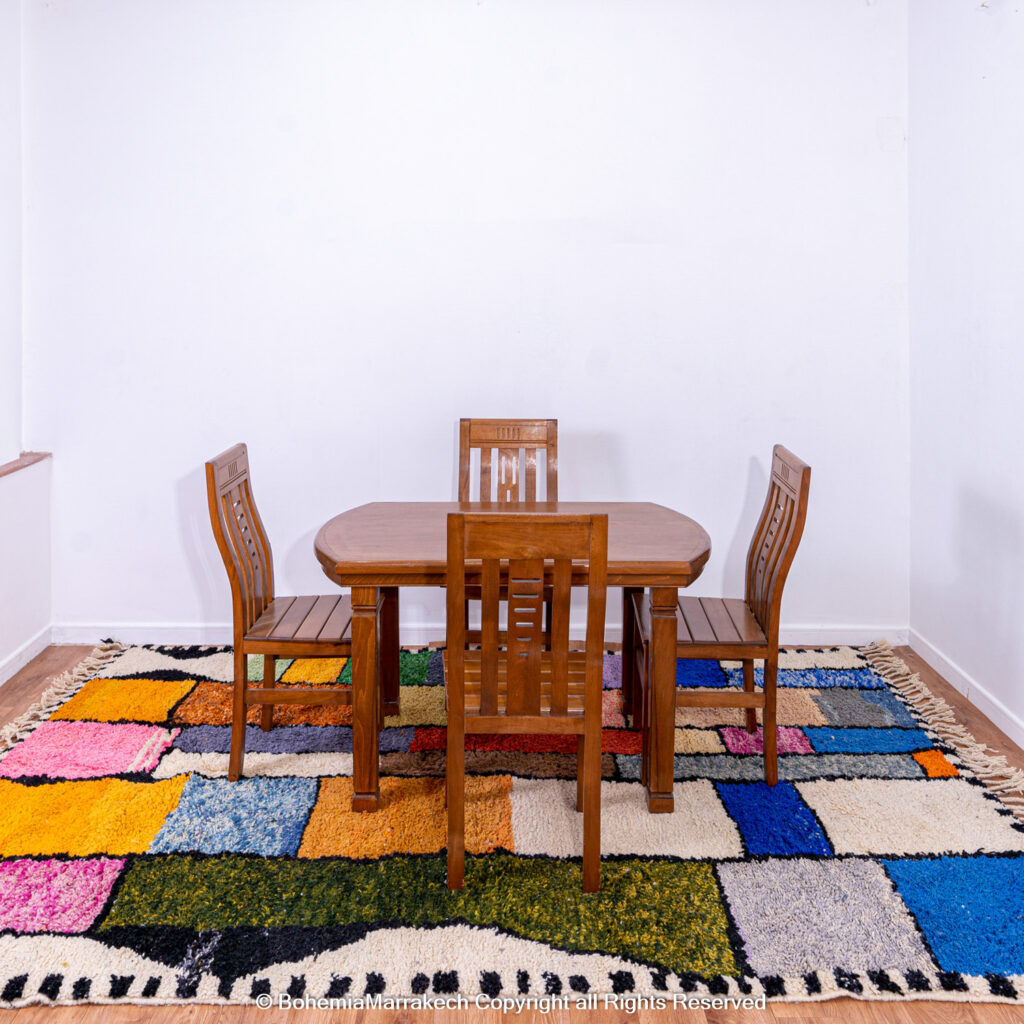

- Indulge in this rug, knowing you're making a positive impact on the planet!
- These rugs are environmentally friendly throughout their production, use, and disposal.
- And as if that's not enough, they contain no synthetic chemicals, making them safe for your home and completely family-friendly.
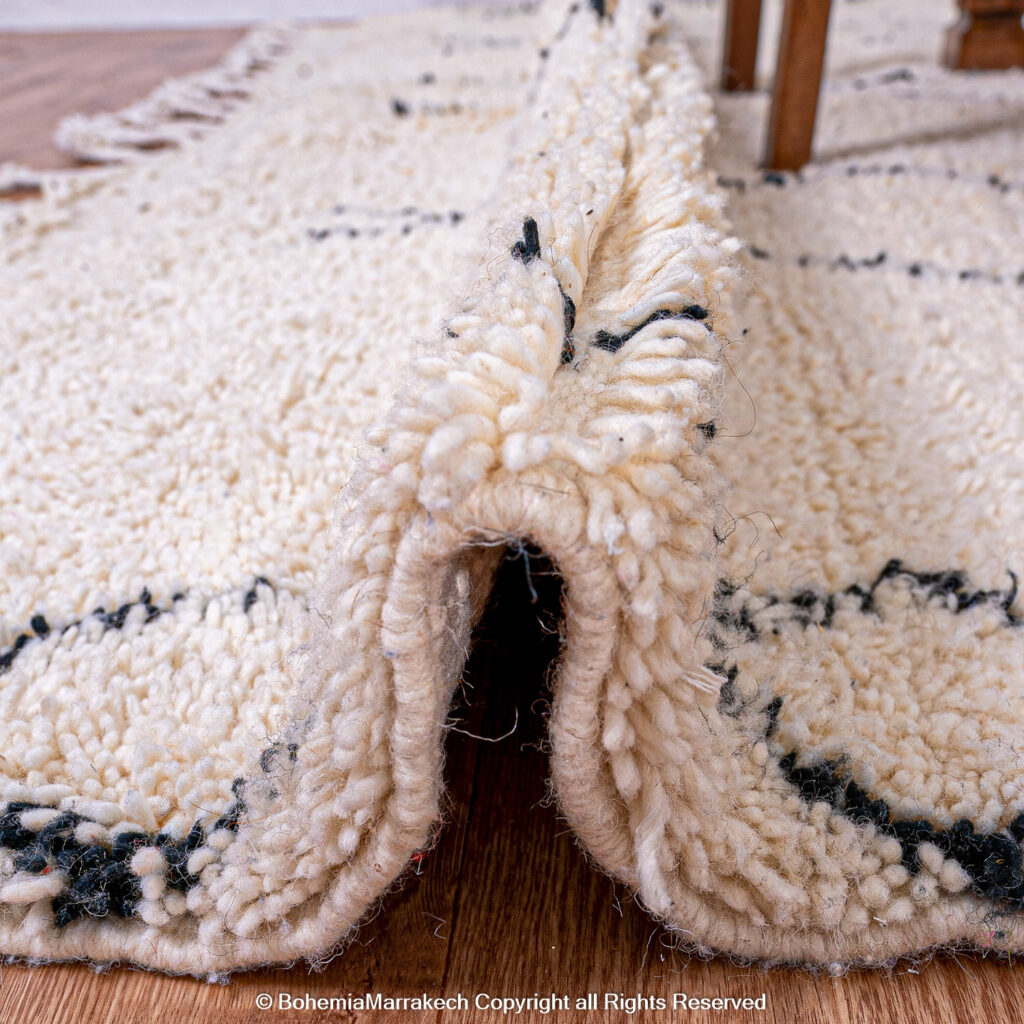
Crafted with Care and Love
Artisanal Mastery: Ethically Handcrafted from Inception to Completion
Pet-Approved Perfection
Tested and Approved: A Treat Your Four-Legged Friends Will Love!
Sustainable Investment: A Greener Future
Durable and Sustainable: Crafted for Generations to Com
Ancestral Wisdom: Passed-Down Know-How




